Anatomical Bequest Program (ABP) Impact
Current

The Story of a UTHSC Alumni: How Thyroid Cancer and Cadavers Shaped Morgan Thomas’ Calling as a Pathologists’ Assistant
Most people don’t think about what happens to the tissue that’s removed during surgery, or the organs examined after a person passes away. But for Morgan Thomas, those moments—the ones most of us never see—are where purpose and passion meet.
Today, Morgan works full-time at the West Tennessee Regional Forensics Center in Memphis, where she helps perform autopsies, process tissue specimens, and support pathologists in determining cause and manner of death. But that’s just part of her story. On most weekends, she also travels to Chicago to work surgical pathology contracts at OSF Hospital. Her schedule is nothing short of packed: she flies out early Friday morning, works Friday afternoon and evening, spends the night in Chicago, and works again Saturday morning before flying back to Memphis.
“It’s a great way to keep up my surgical grossing skills and also make a little extra money,” she says with a laugh. “It’s definitely a busy life, but I really love what I do.”
Before becoming a pathologists’ assistant, Morgan spent five years working in surgical labs in Kansas City, performing gross dissections on organs, biopsies, and cancers—essentially acting as the eyes and hands for the pathologist. “We describe what we see and take the necessary margins and measurements which helps doctors determine how invasive a patient’s next treatments need to be,” she explains. It’s high-stakes work that requires attention to detail, precision, and a deep understanding of human anatomy.
Her work in forensics is equally demanding, especially since the number of pathologists’ assistants (PAs) working in medical examiner’s offices is still very small—just 38 nationwide. In Shelby County, Morgan and her colleagues handle everything from full autopsies to complex organ dissections and even skeletal remains. “We recently assisted forensic anthropologists with bone processing,” she says. “Sometimes we go out on scenes to assist the pathologist in determining whether something is human or animal tissue.”

But what truly sets Morgan’s story apart is what brought her to this field in the first place.
At 16, Morgan was diagnosed with thyroid cancer. She underwent surgery to have her thyroid removed, followed by two rounds of radiation. “It was hard at the time, and it’s still something I carry with me,” she says, candidly. “But looking back, I honestly think it put me on this path.”
Years later, while shadowing a pathologist at the University of Kansas Health System, she discovered something unexpected: her own pathology slides—the ones created during her cancer treatment—were being used as teaching tools. “It was surreal,” she says. “I thought, wow, someone did this for me. That really planted the idea that maybe I could do this for someone else.”
Morgan originally considered medical school, thinking she might follow in the footsteps of her grandfather, who was a pathologist. But after struggling with motion sickness from using microscopes, she realized that becoming a pathologist might not be the right fit. “I love anatomy, and I loved dissection,” she says. “But I needed a path that allowed me to be hands-on without spending all day under a microscope.” That’s when a pathologist she was shadowing introduced her to the work of Pathologists’ Assistants. One visit to the gross room later, and Morgan was hooked.
When it came time to choose a graduate program, Morgan found the perfect match in UTHSC’s Pathologists’ Assistant Program. “Michael Weitzell, the program director, was honestly the reason I chose UTHSC,” she says. “He’s incredibly kind, passionate, and has this gift for making students feel understood and supported. His teaching style and the way he structured the program just really clicked with me.”
Another major factor? The anatomy lab.

“We quite literally cannot do our job without the cadaver lab,” Morgan says. “You can look at pictures in a textbook all day, but until you’ve actually dissected the body yourself, you don’t truly understand how everything fits together.”
Morgan and her classmates went far beyond basic dissections. “We dissected one of the legs so we could really study the cruciate ligaments, the muscles, and the vasculature down into the foot,” she recalls. “We also fully dissected the brachial plexus in the shoulder—it was beautiful. You can’t replicate that kind of learning any other way.”
For Morgan, that hands-on learning laid the groundwork for everything she does now, both in surgical and forensics settings. “It’s not just about learning the anatomy—it’s about understanding margins, how we take out organs, and why we do it that way. The cadaver lab gave us that foundation.”
She’s also quick to point out how valuable that experience is for students who haven’t had previous exposure to autopsies or grossing. “It’s such an essential part of the learning process. It allows you to enter clinical work with confidence instead of confusion.”
These days, Morgan still reflects on her time in the lab often—especially during complex dissections or when she’s mentoring newer Pathologists’ Assistants. And while her work might seem far removed from that scared 16-year-old patient, Morgan sees the full circle clearly.
“I know I don’t interact with patients directly, but I treat every specimen with care and empathy because I’ve been on the other side of it,” she says. “Someone once did this work for me. Now I get to do it for someone else.”
And that, for Morgan, makes the long flights, packed weekends, and early mornings all worth it.
Archive
Finding His Calling: Memphis Native and Dental Student Raja Khan’s Journey to His Second Career
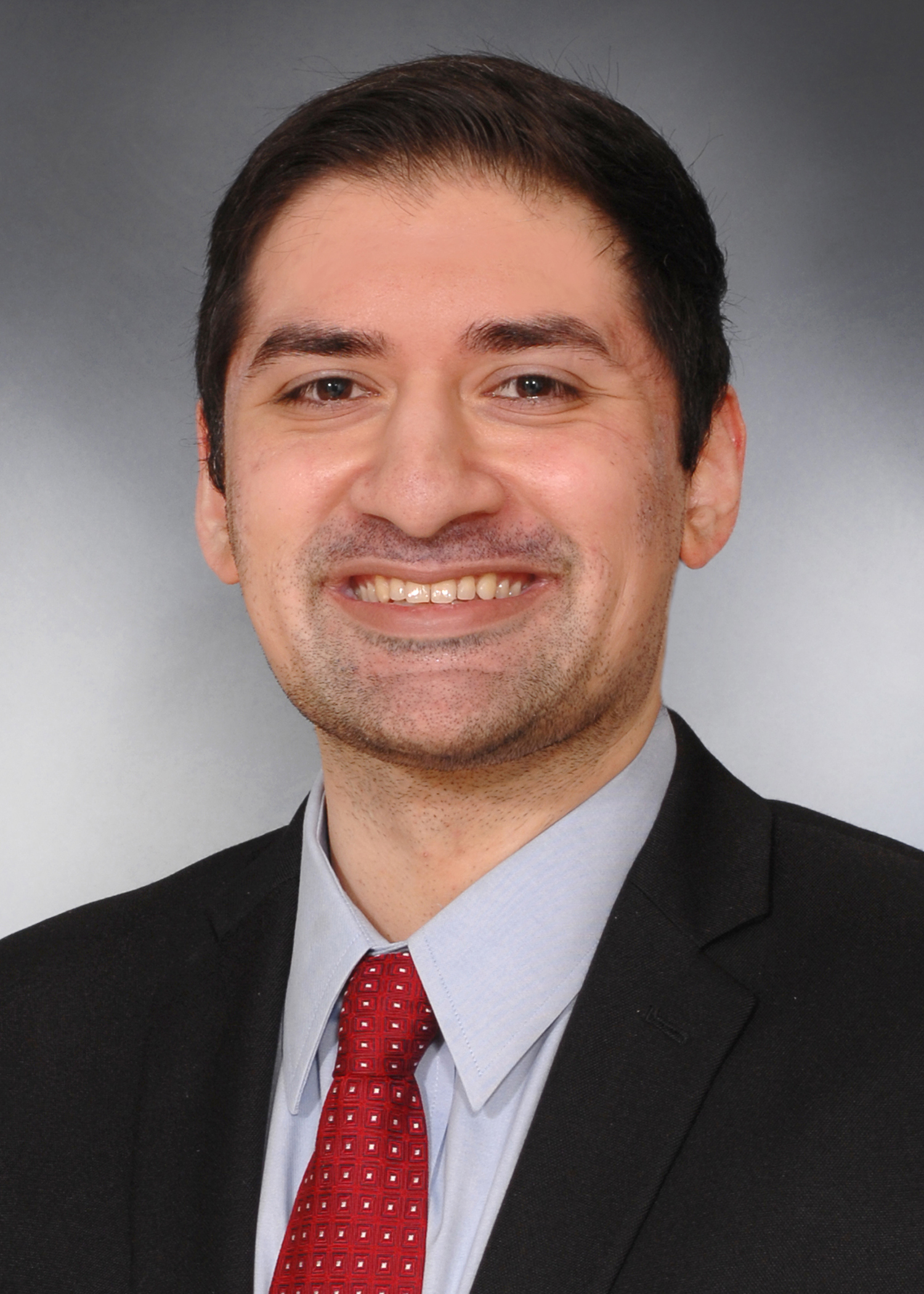
Raja Khan’s journey to becoming a dental student at the University of Tennessee Health Science Center is one of perseverance, determination, and a deep appreciation for hands-on learning. Born and raised in Memphis, Tennessee, Raja’s story is a testament to the idea that educational aspirations can be pursued at any stage in life. While his path to dental school wasn’t traditional, it has shaped him into a dedicated student who is excited to make a difference in the field of dentistry.
Using Education to Pursue a 2nd Career
After graduating from White Station High School in Memphis, Tennessee Raja earned his bachelor’s degree in neuroscience from Rhodes College. However, he didn’t immediately transition into dental school. Instead, he entered the workforce. A few years down the road, he found himself feeling unfulfilled and wanting more out of his life. He pursued a master’s degree in pharmacology from the University of Cincinnati and gained valuable experience working in research in the Memphis area. Along the way, Raja faced personal challenges and obstacles that he had to overcome, but he never lost sight of his goals. “I’m grateful and excited to be where I am now,” Raja shared. His journey serves as an inspiring message to anyone who might have reservations about furthering their education simply because they don’t fit the societal norm of a college student in their 20s.
Raja’s interest in dentistry was sparked in 2019 when he decided to shadow a local dentist. “I really enjoyed the culture and atmosphere that I felt in the dental office,” he recalled. That experience solidified his decision to pursue a career in dentistry, leading him to UTHSC. For Raja, choosing UTHSC was an easy decision. As a lifelong Memphian, staying close to family and friends was a significant factor. Additionally, the College of Dentistry’s reputation for producing high-quality dental professionals assured him that he would receive an excellent education and be well-prepared to enter the field.
Journey Through Dental School
Currently in his second year of dental school, Raja is eagerly anticipating the hands-on clinical experiences that begin in the third year. “I prefer more hands-on experience over textbook learning,” Raja explained, making the anatomy lab a pivotal part of his educational journey. The gross anatomy lab, which takes place during the second semester for dental students, has been one of the most memorable and impactful experiences for Raja. “The amount of information you are required to master in anatomy is overwhelming, but the excellence of the faculty really helped me throughout the semester,” he said. “It was one of the most memorable experiences I’ve had and is something I definitely do not take for granted.”
The anatomy lab offered Raja a unique opportunity to deepen his understanding of human anatomy, particularly in the head and neck area—a crucial focus for aspiring dentists. “Structures of the face are very complicated, and just trying to learn the vessels and nerves from a textbook is nearly impossible,” Raja noted. Being able to see the anatomy firsthand in the lab is essential for dental students to learn, identify, and understand how the anatomy works so that they can apply what they learn when they start working on actual patients.
Whole-Body Donation Enhances Learning
The hands-on experience of dissecting a cadaver was invaluable for Raja. “I think what really helps you learn anatomy is having the opportunity to work on and study the donors in anatomy lab,” he said. He points out that, “Being able to perform a dissection and find the structures and how they relate to other structures of the body makes a connection in the student’s mind that they cannot get any other way.” While the technical aspect of the dissection was a significant learning experience, Raja never lost sight of the humanity of the donor. “When you are in the lab and doing the dissections, it can be easy to get lost in the process of learning anatomy, and forget that you are working on an actual human being,” he reflected. “I always tried to remember that the donor had a family and friends who loved them and that they lived a full life.”
Raja’s gratitude for the donor’s gift of education is profound. “If I were able to see their family, I would tell them that I am personally very thankful for the opportunity that I had, and that I tried to remain very respectful throughout the remainder of our anatomy course,” he shared. “For me personally, and for other students, we gained a great understanding of anatomy which is going to aid us in our profession, and I tried to ensure that the reason for the individual’s choice of becoming a donor was achieved through the knowledge that I gained.”
A Future Dentist in the Memphis Area
Looking ahead, Raja hopes to stay in Memphis after dental school to serve his community. However, he remains open to relocating if necessary for his first job. His dedication to his education and his determination to overcome obstacles make him a standout student at UTHSC. Raja’s story is a powerful reminder that the journey to success doesn’t have to follow a linear path. Whether it’s navigating personal challenges, pursuing advanced degrees, or mastering anatomy in the cadaver lab, Raja’s experiences have prepared him to excel in the field of dentistry and make a meaningful impact in the lives of his future patients.
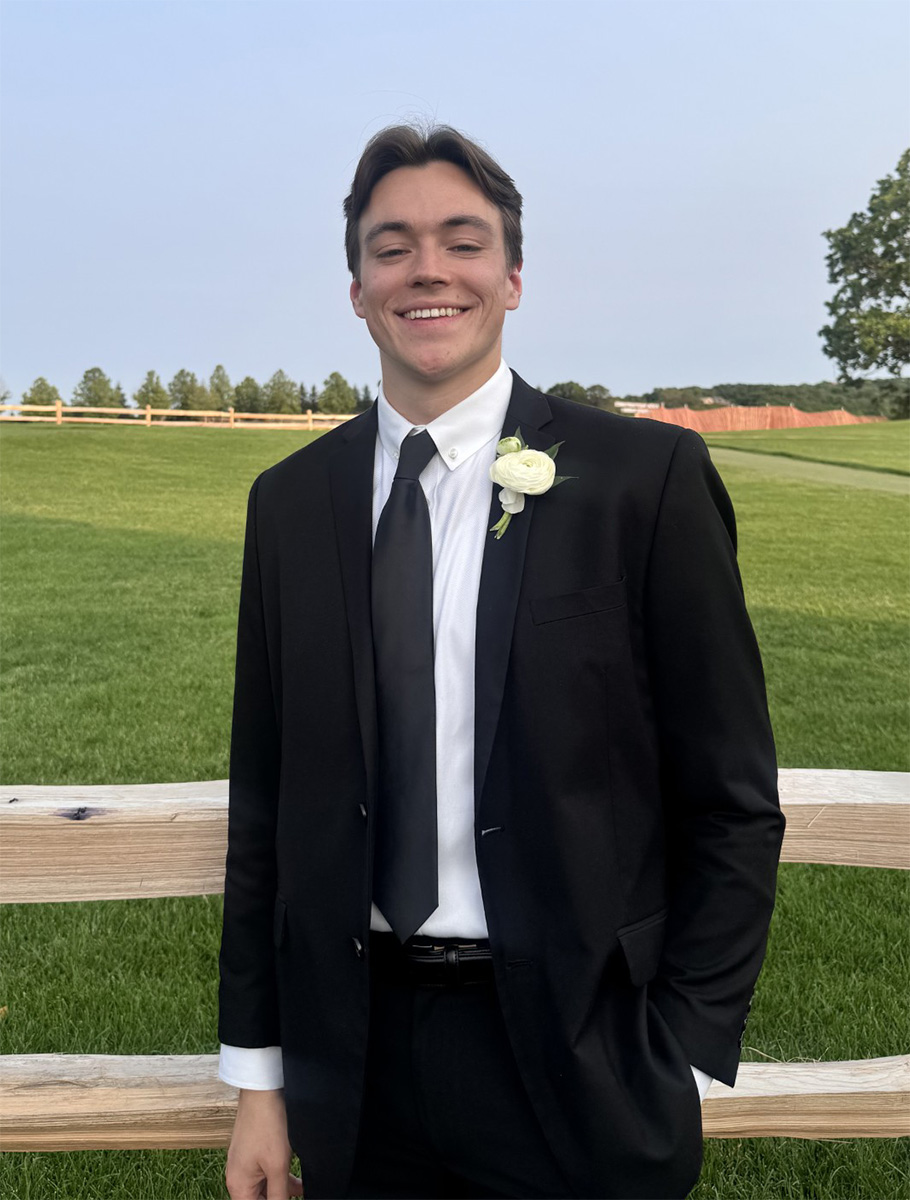
Inside the Lab: A Future Dentist’s Career Impacted by Gross Anatomy
From the small town of Jonesboro, Arkansas, to the rigorous halls of UTHSC’s College of Dentistry, second-year dental student Kallen Smith has always followed a path defined by curiosity, determination, and a deep respect for science. A graduate of Brookland High School, Kallen’s early years were filled with a wide range of activities—he served as class president, competed on the swim team, captained the Quiz Bowl team, and took part in the Spanish club. That balance of leadership and academic discipline laid the foundation for the future healthcare provider he is becoming.
Kallen began his undergraduate studies at Ouachita Baptist University as a pre-med student. It wasn’t until a thoughtful conversation with his college advisor that he began to question if medicine was truly his calling. “She asked me, ‘Are you prepared for your career in medicine to be the number one most important thing in your life?’” Kallen recalls. “My answer was no, and so she said let’s take your passion for health science and find something that fits better for you.” That advice became the pivot point in Kallen’s journey. After shadowing a dentist, he knew he had found his passion. “Dentistry is what I was looking for without knowing it,” he said.
At UTHSC, dental students take gross anatomy during their second semester, and for Kallen, this was an experience he had been anticipating for years. “I remember being very excited about the lab but also kind of worried about whether or not I could handle the course load,” he said. The intensity of the first semester had already introduced him to the challenge of professional school, but stepping into the anatomy lab was something entirely different.
“The first day of lab was the first time that I felt the weight of the circumstance that I was in and how it was so unique,” Kallen explained. “I don’t think I felt fear related to the cadavers, I just remember being very interested in it and thinking it was an incredible opportunity.” He quickly developed a deep respect for the individuals who had chosen to donate their bodies to science. “As the semester progressed and we were exploring and dissecting each part of the cadaver, I remember still feeling the weight of what the donation process represents... It is something that is so interesting and respectable for someone to do at the end of their life.”
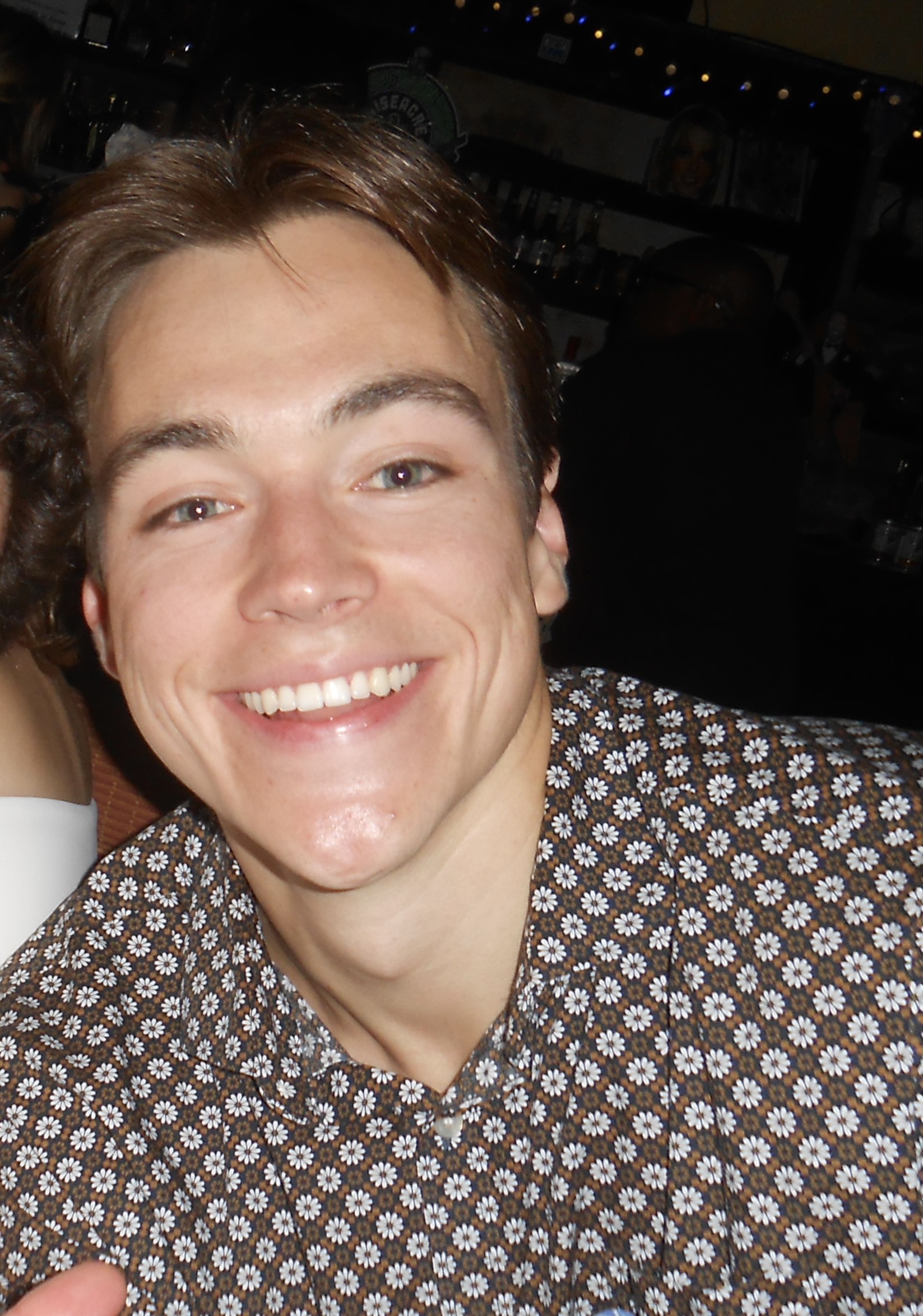
Kallen spent countless hours in the lab, attending three days a week, and frequently coming in on weekends to continue studying. Those moments in the lab soon helped him realize that his donor would become a deeply integrated part of his educational experience at UTHSC. “There’s just an air throughout the gross anatomy lab that everybody feels. You get used to it, but it’s still always there... It was a weight that you were respectful towards.”
Even in the middle of mastering challenging coursework, Kallen often found himself thinking about the donor. “I was super focused on learning and studying, but there were many times where I found myself wondering about the person whose body this was,” he said. “It just made me think of people in my own life that aren’t present anymore... this was a really selfless act that this person gave for my education.”
When asked what he would say to a donor’s family, his response was simple but heartfelt: “I would tell them that I was super grateful for their loved one’s sacrifice but also their own sacrifice... their influence and legacy will continue on through all of the students who had the opportunity to learn from them.”
Now, with more of his dental education underway, Kallen says that gross anatomy has influenced nearly every course he has taken since. “Being able to relate the organs and structures of the body to what I was able to physically see in gross anatomy helps me in all of my other courses,” he said, adding that his knowledge of head and neck anatomy in particular will be vital for his future dental practice.
Looking ahead, Kallen hopes to return to Arkansas to serve his home state and eventually open his own dental clinic. Each step of his education, especially his time in the anatomy lab, has contributed to a deeper understanding of the human body—and the responsibility that comes with treating it.
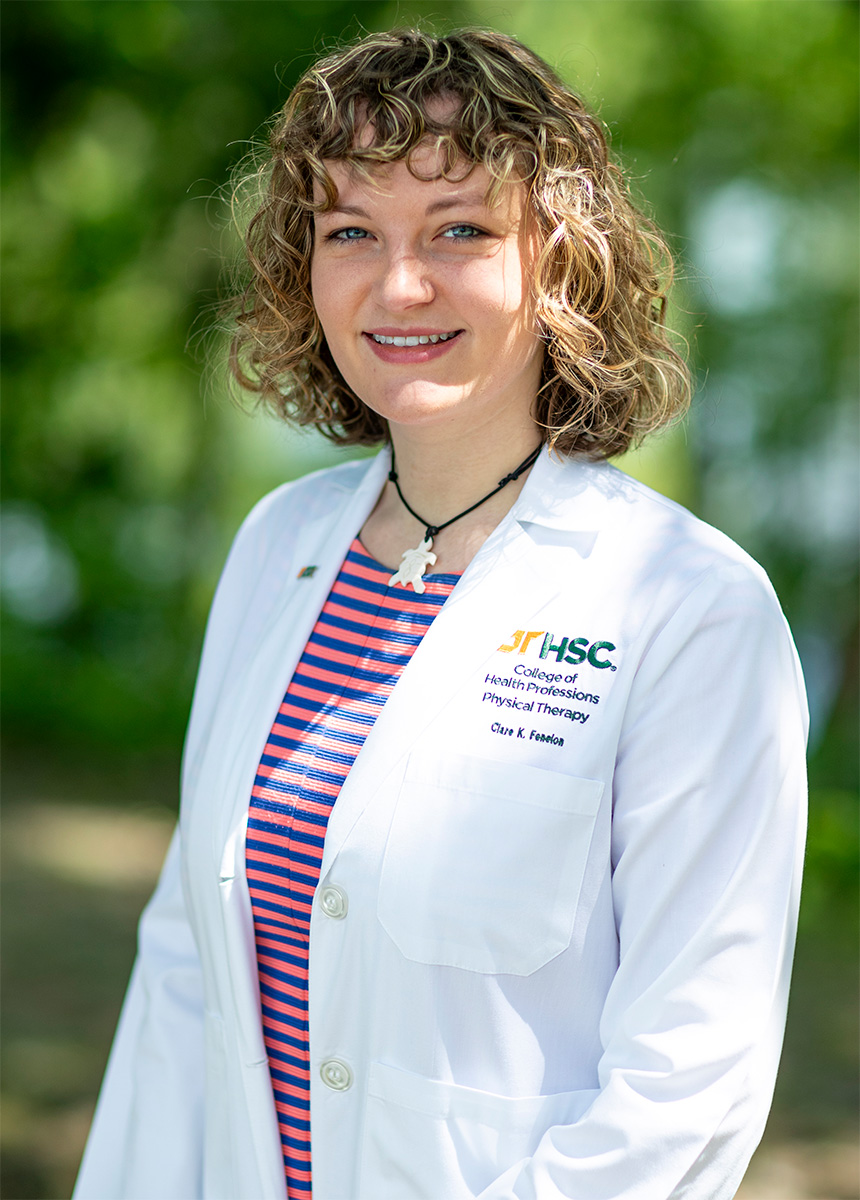
Clare Fenelon is a Doctor of Physical Therapy student at the UT Health Science Center, where she is preparing for a career that will enable her to help individuals regain mobility and improve their quality of life. As part of her rigorous training, Clare has spent significant time in the university’s Gross Anatomy lab, an invaluable resource made possible by the Anatomical Bequest Program.
Clare grew up in Lynchburg, Virginia. She has been drawn to the medical field since second grade. After graduating from E.C. Glass High School, Clare enrolled at the College of William & Mary and began working on her undergraduate degree. She was initially focused on medicine, orthopedics in particular, but after spending time in the cadaver lab at William & Mary, her interests migrated to Kinesiology: the study of human movement, performance, and function. Clare quickly saw the relationship between Kinesiology and physical therapy and steered her collegiate efforts away from orthopedics.
Growing up, Clare attended summer camp in Crossville, Tennessee. Those summers at camp helped her develop a love for the state of Tennessee which, along with the school’s standards of excellence, led her to apply to the Physical Therapy program at UT Health Science Center.
For Physical Therapy students like Clare, a deep understanding of human anatomy is critical. The ability to palpate muscles, identify joint structures, and comprehend how different tissues interact is essential for diagnosing and treating patients. While textbooks and digital models provide useful information, nothing compares to hands-on experience with real human donors. The Anatomical Bequest Program at UT Health Science Center allows students to develop a tactile and visual understanding of the human body in a way that no other method can replicate.
Physical Therapy students take Gross Anatomy in their second semester of graduate school. Gross Anatomy Lab is often a defining experience for students in the Physical Therapy program. Clare, like many of her peers, has found that working with human donors bridges the gap between theoretical learning and practical application. “I’m more of a tactile learner, so for me, being able to put my hands on the muscles and be able to see where they attach to the bones or where the nerve innervations are was very valuable,” she said. By dissecting and examining real anatomical structures, she has gained insights that will shape her future approach to patient care.
Beyond the technical skills, the experience also creates a deep sense of respect and appreciation for those who have chosen to donate their bodies for medical education. These donors provide an unparalleled learning opportunity, allowing students to see variations in anatomy and better understand the complexities of the human body. The lessons learned in the lab go beyond scientific knowledge—they instill a sense of gratitude and ethical responsibility that will stay with students throughout their careers. In speaking of her donor, Clare said, “If I were sitting down with a family whose loved one decided to donate their body, I would want them to know that the donation of their loved one was used for its intended purpose. The value that I personally got out of UT’s body donors is immeasurable. I cannot imagine trying to do physical therapy without having worked with the cadavers. I know that all of the students in my physical therapy program are extremely grateful, myself included.”
UT Health Science Center has long been committed to providing its students with high-quality, hands-on education, and the Anatomical Bequest Program is a key component of that mission. By ensuring that students have access to human donors, the university is equipping future healthcare professionals with the skills and knowledge they need to provide exceptional patient care. Clare’s experience in the lab has reinforced her decision to pursue physical therapy and has given her a strong foundation to build upon as she advances in her studies.
As Clare continues her journey toward becoming a physical therapist, she carries with her the invaluable lessons learned in the Gross Anatomy lab. The Anatomical Bequest Program has not only enhanced her understanding of the human body but has also deepened her appreciation for the generosity of donors who make this education possible. With a solid foundation in anatomy and a passion for helping others, she is well on her way to making a meaningful impact in the field of physical therapy.
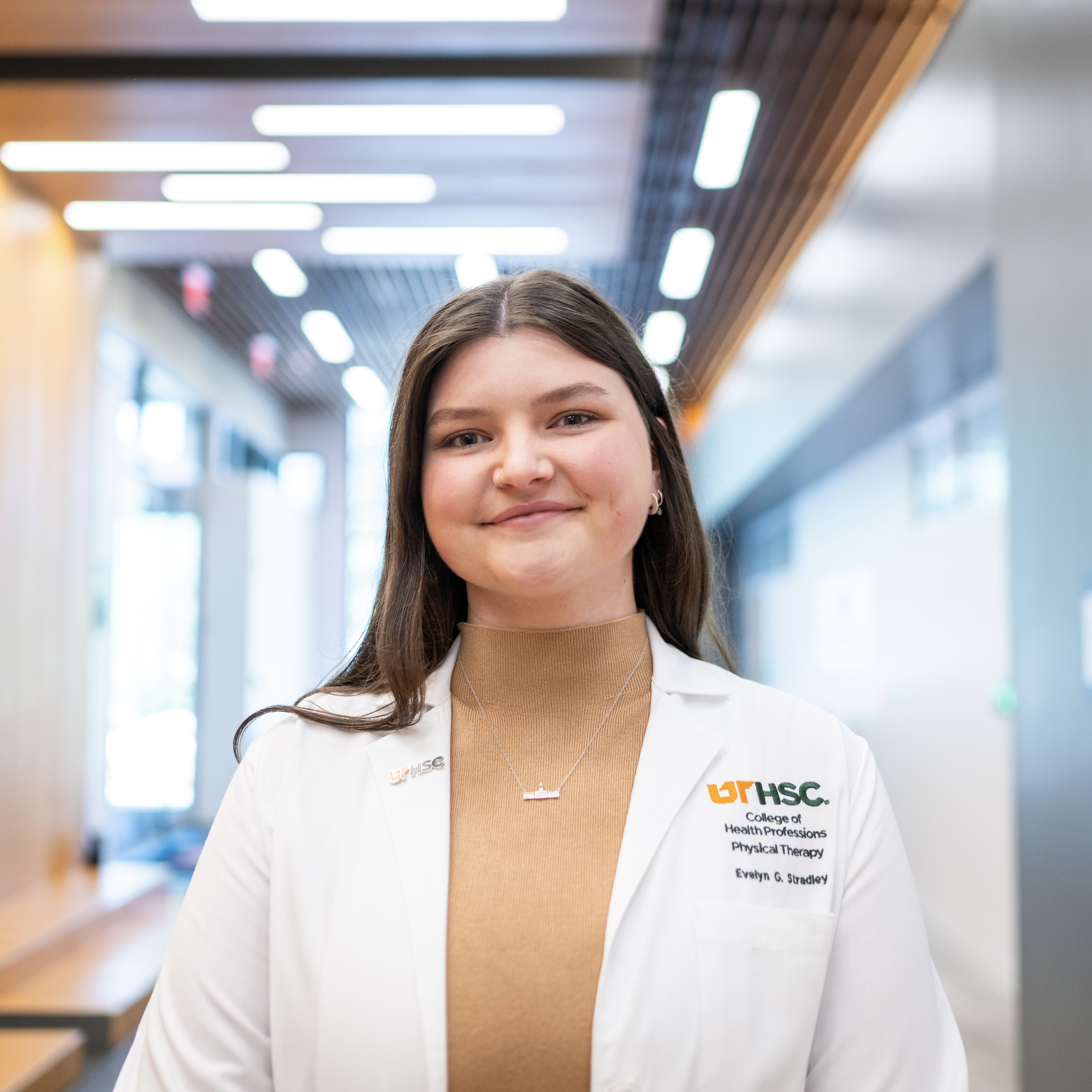
“It All Comes Back to Anatomy”: Evy Stradley Reflects on How the Anatomy Lab Shapes Her Path in Physical Therapy
Evy Stradley didn’t grow up thinking she’d go into health care. With a father in financial consulting, a mother in accounting, and a younger brother pursuing a PhD in chemistry at Notre Dame, she was surrounded by analytical minds—but none in clinical fields. It wasn’t until high school, through a clinical rotation program, that her path began to take shape.
“I grew up in competitive dance and was lucky not to get injured myself, but I saw a lot of my friends go through various things,” she said. “I found it fascinating that they were able to use exercise or movement to heal those injuries rather than just sit out.”
Evy grew up in the Dallas, Texas area. Through her high school’s clinical rotation program, Evy was able to shadow professionals across multiple specialties—orthodontics, radiology, physical therapy, and more—spending two hours every morning getting real-world exposure. “It was really great,” she said. “We got to see virtually anything involved in health care.”
Evy left Dallas for college, heading northeast to Penn State University, where she thoroughly enjoyed her undergraduate experience. She loved being part of a campus where she could study hard and also participate in things like THON—the university’s student-run philanthropy, which is the largest of its kind in the world.
When it came time to choose a physical therapy program, Evy stumbled on UTHSC somewhat accidentally. “I actually applied to UTHSC by accident,” she admitted. “But as I went through the interview process and compared it to other schools, it was clear how much the faculty cared about producing good clinicians and good colleagues.” She was also drawn to the focus on graduate-level education without an undergraduate program overshadowing it. “I really appreciated that UTHSC is just a graduate science campus.”
Like all physical therapy students at UTHSC, Evy took gross anatomy during her second semester. “Going into that second semester, I think a lot of your first semester is spent getting into the idea of what school is,” she said. “But you always have the thought process going into PT school that you need to know the anatomy—like, learning human anatomy is paramount to what I’m going to do as a physical therapist.”
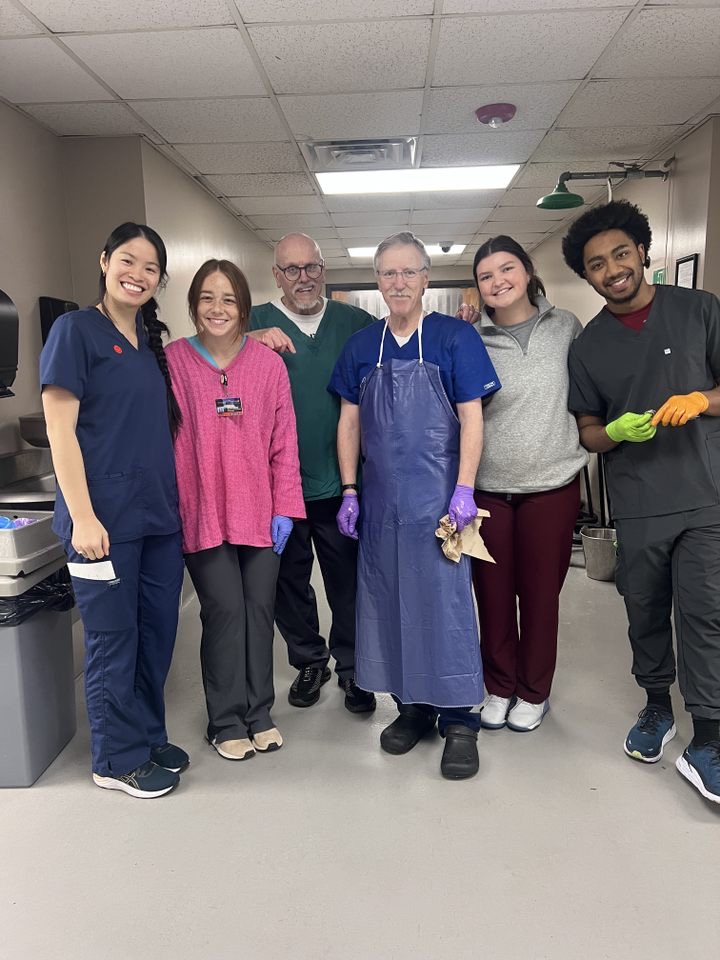
For Evy, finally getting into the gross anatomy lab felt like a milestone: “It feels like you’ve sort of made it as a PT student.”
Unlike her undergraduate experience—where she worked with pre-dissected specimens—UTHSC gave her the opportunity to do the dissections herself. “That has helped me learn human anatomy in such a different way—to understand the steps of how I got somewhere, or to problem solve with what was in front of me.”
She noted how important it is for physical therapists to be able to conceptualize what’s happening beneath the surface of a patient’s body. “Lab helps you gain an ability to problem-solve while you're looking, which is such an important part of learning for physical therapy, because so much of what we do requires surface anatomy knowledge.”
That hands-on experience has stuck with her. “I think that initial semester in lab feels like such a rapid increase in what you’ve learned—from day one until the ten weeks is over. The amount of knowledge you’re consuming is more exciting than it is intimidating.”
Evy described the lab as being especially meaningful for a group of students who tend to be kinesthetic learners. “So many physical therapists learn best through doing—being able to interact with a cadaver in that way is invaluable.”
Her time in the anatomy lab didn’t stop after that first semester. She later returned to the lab as a teaching assistant for the next class of physical therapy students. “Being able to go back and see all of those structures with a little more knowledge and understanding than what I had the first time just makes everything make triple sense,” she said. “That experience has completely changed the trajectory of the rest of my academic career.”
For Evy, the learning from lab continues every day. “It’s not the slides or lectures that I remember when I’m recalling information from past classes—it’s my experience in the anatomy lab,” she said. “Even today, we were working on upper limb neurodynamic testing. The purpose is to tension that nerve as much as we can, and I was able to think about how I tracked the brachial plexus all the way down to the wrist. I used that experience from the lab to have success in learning that concept in my current class.”
Whether it’s palpating a muscle, running a stress test for ligaments, or just understanding how movement happens, Evy said her time in the anatomy lab informs everything. “To be able to visualize what those structures look like in a human body, and to remember moving my cadaver in that certain way—that will help me in practical scenarios both in classes and in my eventual practice as a physical therapist.”
“If I didn’t have that time in the lab,” she added, “I don’t think I could be the physical therapist that I hope to be.”
When asked what she would say to the donor and their family, her answer was clear. “I think I would want to express my gratitude first. That is one of the most selfless decisions you can make at the end of your life—to provide someone else the opportunity to learn from you,” she said. “One of my family members is planning on donating their body after they pass, and I just think it’s incredible.”
Evy remembers one moment in the lab when her group paused before beginning a dissection. “We spent a long time right before we started just sitting there and recognizing that this is a human being with family members and friends,” she recalled.
Looking ahead, Evy is still figuring out where she wants to go. She’s considering Chicago or the Carolinas, but for now, she’s focused on the type of clinical environment that will suit her long-term.
Wherever she ends up, one thing is certain: the foundational experiences she gained at UTHSC, in anatomy lab and other settings, will be part of every patient interaction.
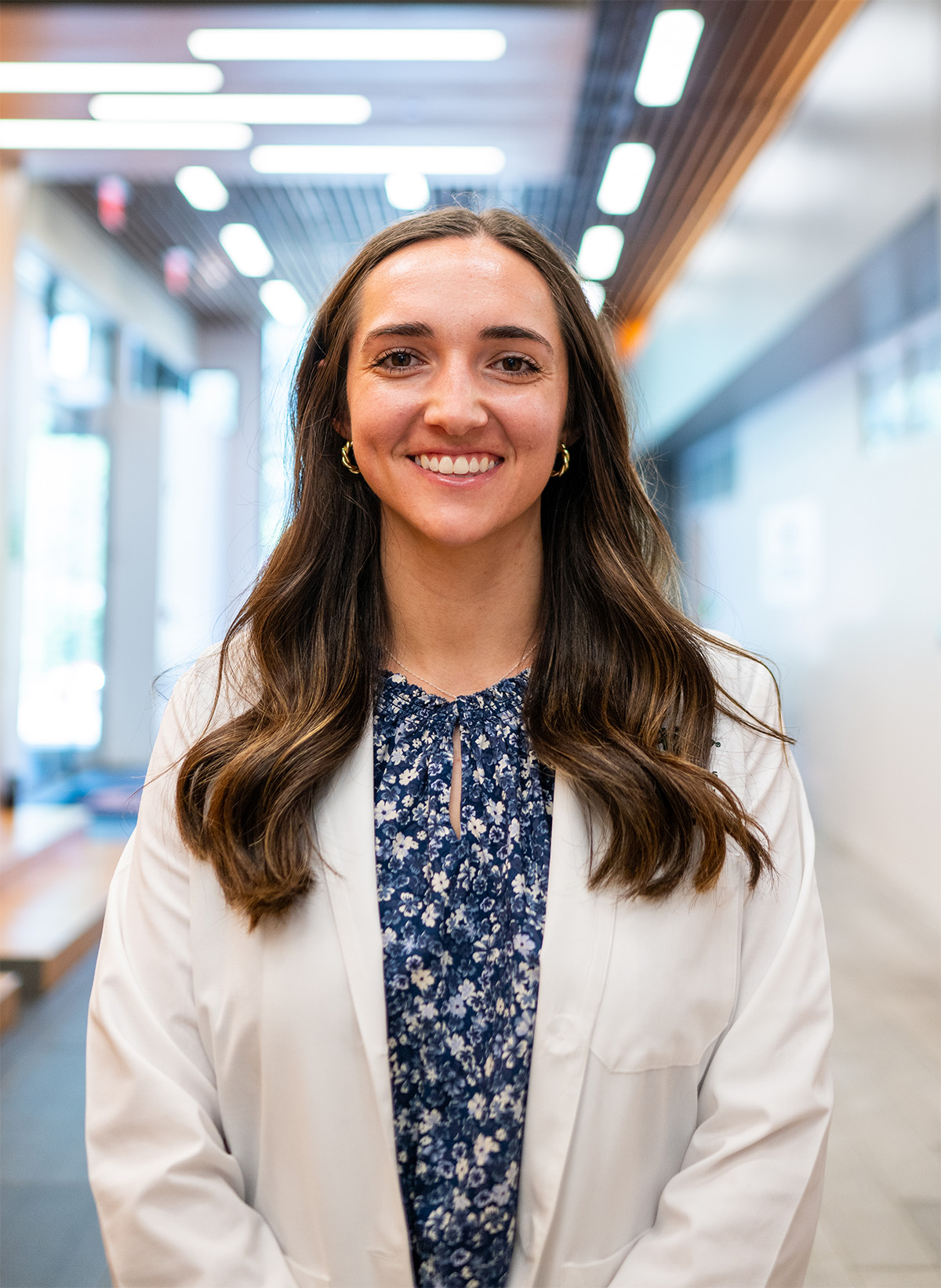
I Am Because of Them: The Lasting Influence of a Silent Teacher
For Sarah Hawkes, the path to becoming a physical therapist began long before she ever stepped foot into a cadaver lab. Born in Jackson, Tennessee, and raised just a short drive east in Lexington, Sarah grew up in a small, tight-knit community where family and faith played a central role. With a county population of around 12,000 and a high school of fewer than 1,000 students, Sarah’s upbringing was shaped by close relationships and deep community roots.
“We moved to Lexington when I was in third grade to be closer to both sets of grandparents,” she shared. Her mother worked in a hospital lab as a cytotechnologist, and Sarah credits her early exposure to the medical environment as one of the initial sparks behind her interest in health care.
As an athlete who spent much of her adolescence on the court and field, Sarah was no stranger to injury. She played a range of sports—cheerleading, basketball, soccer, and volleyball in middle school—before narrowing her focus to volleyball in high school, even joining a competitive traveling team. Injuries led her to spend time in physical therapy clinics, and it was during one of those recoveries that something clicked.
“I asked my physical therapist if I could volunteer,” she said. During her time as a volunteer in that clinic, she helped treat a little girl who was diagnosed with Spina Bifida. Sarah recounted the moment when, after months of hard work, the little girl was able to walk with a walker and braces: “I remember exactly where I was in the clinic—my heart was a puddle on the floor, and I decided right then and there that this is what I wanted to do.” She knew that helping people reclaim their mobility and independence—whatever their “new normal” might look like—was her future.
After graduating from Lexington High School in 2017, Sarah pursued her undergraduate studies at the University of Tennessee at Chattanooga. There, she not only stayed committed to her PT goals but also got involved with CRU, a campus ministry that helped her deepen her faith alongside friends in her sorority. After earning her degree, Sarah took two years off to reflect and refocus, exploring other interests and even briefly considering other career paths. But the pull toward physical therapy never faded. When she was accepted into PT school, she knew she was where she was meant to be.
At the University of Tennessee Health Science Center, physical therapy students take gross anatomy in their second semester. Sarah remembers the first day clearly.
“It was a little bit shocking,” she said, recalling her initial response to the cadaver lab. But the feeling didn’t last. Soon after her initial feelings of uneasiness went away, Sarah stated that her thought processes changed to gratitude and awe. “This is a person—they had a life and a family and knew people—but yet they also decided to donate their life so that I could learn and so that I could become the best clinician possible. So after I got through the initial shock of the situation, I quickly realized how grateful I was for this person and my ability to learn from them and their bodily structures.”
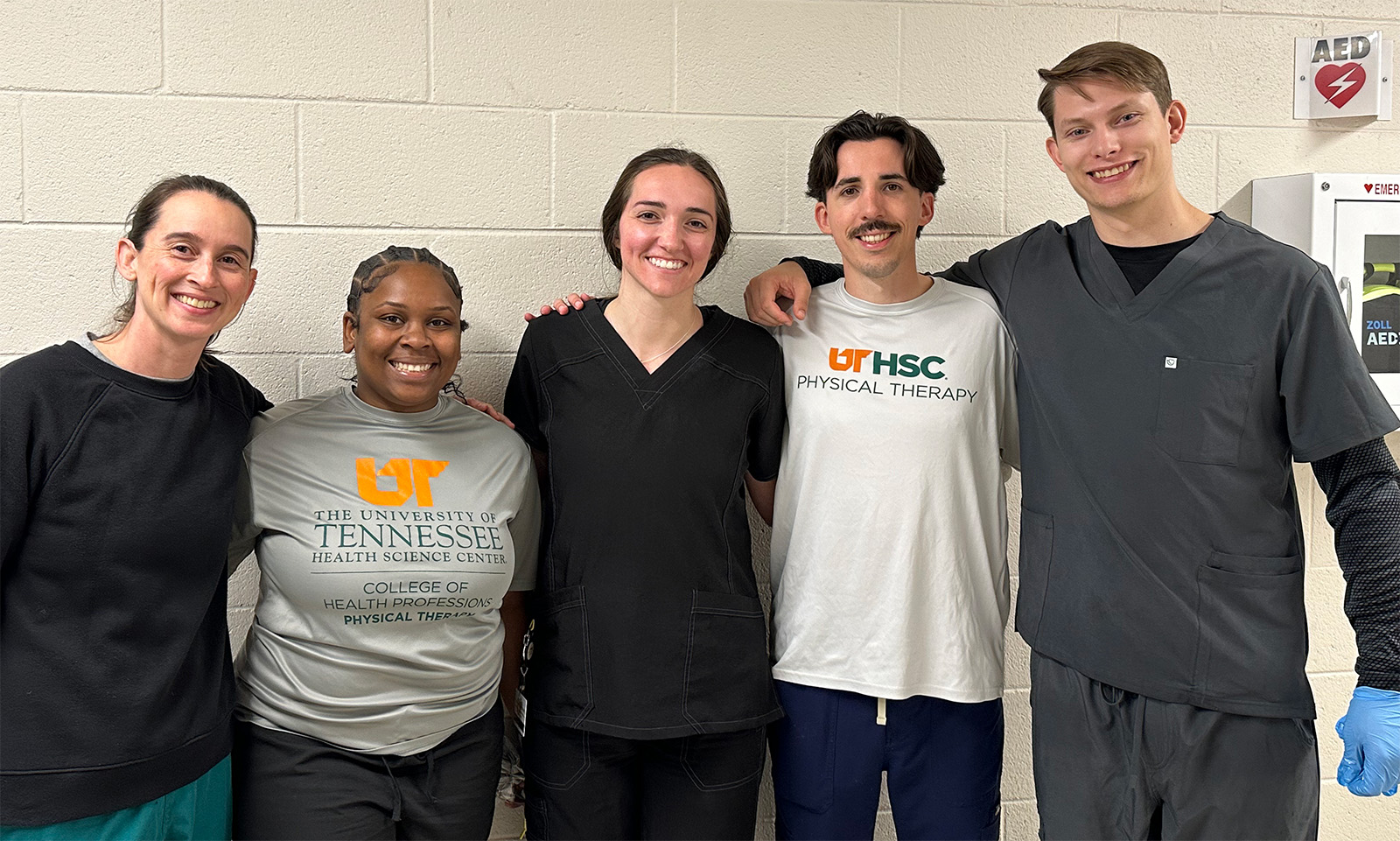
Sarah’s appreciation for hands-on learning stems, in part, from her earlier anatomy courses. “At my undergraduate when I took anatomy and physiology, we didn’t have cadavers—we actually dissected mink—and I remember wondering, ‘How is this helping me right now?’” She also took an anatomy course at a community college during her gap years that relied heavily on pictures and textbook descriptions. “Even still, I wouldn’t say I had adequate knowledge of human anatomy at that point in my schooling.”
What made the difference, she said, was being able to physically interact with the human body. “Being able to interact with a human donor and apply what I was learning in my textbook to what I was seeing firsthand with the cadaver has made all the difference for me.” The impact of her anatomy experience hasn’t faded. “It’s been a year since I’ve taken anatomy, and I reference back to it all the time to be able to pull together what I am learning,” she said.
Physical therapists, she noted, need something like X-ray vision—an intuitive understanding of what’s happening under the skin. The gross anatomy lab gave her that essential foundation.
“I genuinely wouldn’t be able to become the physician that I am, or the physician I am going to be, without having the knowledge and experience that I gained from my donor,” Sarah said. “I want the families of the UTHSC body donors to know how impactful these donations are on the students’ education and career.”
Looking ahead, Sarah hopes to return to the Jackson–Lexington–Parsons area to serve the same community that helped raise her. Equipped with gratitude, knowledge, and a clear sense of purpose, she’s ready to help others around her get back on their feet—both literally and figuratively.
The Pathologists’ Assistant: UT Health Science Center’s Commitment to Training the Next Generation
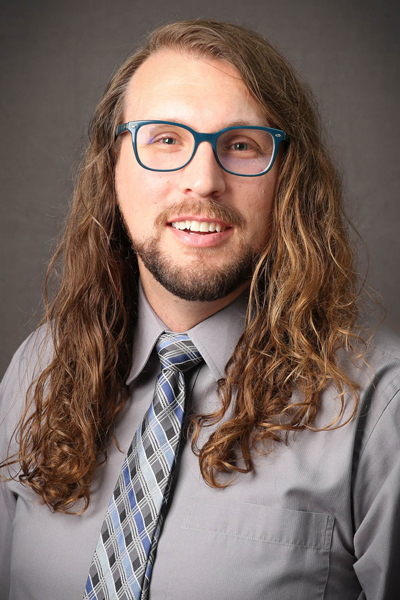
When interacting with a doctor’s office, it is common to hear the phrase “We’re waiting on the lab results”…but what does that actually mean? Within this unfamiliar lab, you’ll find a team of highly trained professionals who are dissecting tissue samples, analyzing them, and searching for answers that could shape a patient’s diagnosis and treatment. Who performs this critical work, and why is it so essential to patient treatment and modern medicine? The job titles for these untold individuals are Pathologists and Pathologists’ Assistants.
Pathologists are trained medical professionals who oversee laboratory testing, ensuring accurate results that will guide their fellow doctors in diagnosing and treating patients. To become a Pathologist, one must complete medical school and undergo additional training that is specific to the role of a Pathologist. Pathologists, and Pathologists’ Assistants, play a crucial yet often overlooked role in healthcare. They are the experts behind the scenes, dissecting tissue samples from surgeries. Their work is a critical element of health care, helping physicians make life-saving diagnoses and treatment plans. Additionally, individuals with these skills and specialties are also found in medical examiner’s offices, performing autopsies which help determine cause and manner of death. Without a doubt, the unfamiliar work of Pathologists and Pathologists’ Assistants is extremely important in our society.
At the University of Tennessee Health Science Center, a growing Pathologists’ Assistant program is training new students, providing them with hands-on experience in its state-of-the-art anatomy lab, and diligently preparing them for a vital career in medicine.
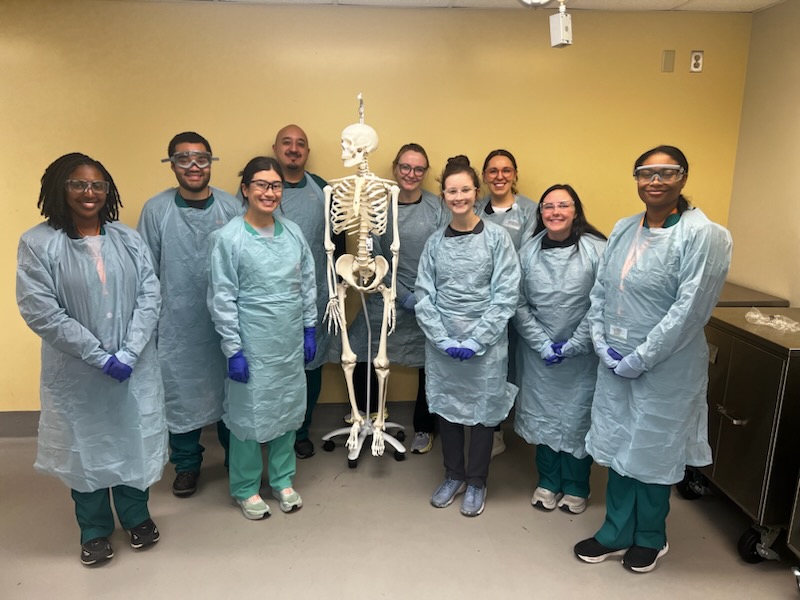
A Growing and Essential Field
While Physician Assistants have long been a staple in the healthcare system, Pathologists’
Assistants have had to fight a little harder for their recognition. Though the field
has existed since the 1960s, it took years to gain traction. Today, the demand for
Pathologists’ Assistants is growing with opportunities expanding in hospitals, research
institutions, and medical examiners’ offices across the United States and Canada.
Their expertise is especially crucial in diagnosing diseases, staging cancers, and
assisting in forensic investigations.
While all medical professions must have an intimate understanding of human anatomy, the interaction that Pathologists and Pathologists’ Assistants have with human tissue on a daily basis requires a level of anatomical understanding that few other specialties can claim to match. “Pathologists’ Assistants do the dissection of any tissue that comes out of surgery,” explains Professor Michael Weitzeil, director of UT Health Science Center’s Pathologists’ Assistant program. “From day one, we are examining skin, we are looking at disease, and we are performing dissections in order to examine the organs of the body. It’s our job to analyze it and help Pathologists and other Physicians determine the best course of treatment for the patient.”
The Introduction of Pathologists’ Assistants at UT Health Science Center
Professor Weitzel’s journey into the Pathologists’ Assistant profession began unexpectedly.
He began his undergraduate career as a collegiate athlete, playing basketball for
Utah Valley University. He would later discover his love for science while attending
Weber State University in Ogden, Utah. While attending school, a friend introduced
him to pathology work at a hospital lab in Salt Lake City, and he quickly became immersed
in the field. “I started out processing tissue from simple cases,” he recalls. “As
I gained more experience, I was trusted with more complex situations.”
This newfound passion led him to pursue formal training at the West Virginia University Pathologists’ Assistant program. After graduation, he moved to California and worked at Loma Linda University where he was an instructor in their Pathologists’ Assistant program. It was also in California where Professor Weitzeil began volunteering with the National Accreditation Association for Clinical Laboratory Science (NAACLS), which helps maintain the rigorous standards applied to accredited Pathologists’ Assistant programs throughout the United States and Canada. In 2020, he moved to Memphis to launch a new Pathologists’ Assistant program at UT Health Science Center, determined to create a top-tier education for future Pathologists’ Assistants.
“We arrived in July of 2020 and immediately continued the approval processes,” Weitzeil explains. Following a few years of hard work and dedication, Weitzeil attended a legislative session where UTHSC officially received the green light from the Tennessee Higher Education Commission. After receiving permission from the Education Commission, and being approved by the University of Tennessee System, the Pathologists’ Assistant program at UT Health Science Center was able to officially open applications for new students. The first cohort began in January 2023 with six students. The program has since grown, admitting 10 students in the second year and 12 in its most recent class. Weitzeil added that the program is continuing its expansion efforts, hoping to take in more students as the years progress.
The Impact of Hands-On Learning
At UT Health Science Center, students enrolled in the Pathologists’ Assistant program
and other Health Profession programs don’t just learn from textbooks—they gain real-world
experience in the anatomy lab. “When our students are in the lab, for many of them,
it’s the first time they have been around the remains of a deceased human,” Weitzeil
says. “I feel a responsibility to help them not only learn human anatomy but to also
understand the level of reverence required to do this job with dignity.”
Studying human cadavers, which is made possible through UT Health Science Center’s Anatomical Bequest Program, provides an irreplaceable learning experience. Pathologists’ Assistants must be able to recognize disease in tissues and organs, differentiate between normal and abnormal tissue and structures, and perform meticulous dissections. This training is particularly crucial in cancer diagnoses, where identifying the exact type and stage of cancer dictates a patient’s treatment plan. “The anatomy lab at UT Health Science Center provides Pathologists’ Assistant students with the foundational knowledge they need to identify normal tissue. This will set the basis for recognizing abnormal tissue in the clinical setting. What we do in the Anatomy Lab at UT Health Science Center with the cadavers will literally lead to the treatment of cancer and the saving of lives,” Weitzeil emphasizes. “By the time they get to their clinical rotations, they will have already seen and began to understand the reasons behind everything they do clinically.”
Respecting the Donor’s Gift
Beyond the technical skills, the UT Health Science Center Pathologists’ Assistant
program instills a deep sense of respect for the individuals who donate their bodies
to science. “Sometimes it can be tempting to revert to humor as a coping mechanism
when dealing with some of the traumatic medical scenarios Pathologists’ Assistants
experience,” Weitzeil acknowledges. “But one of the core principles we emphasize early
on at UT Health Science Center is that these donors are human beings. Their bodies
are one last gift to the world. We honor their sacred gift as we learn everything
we can from what each donor has provided us.”
This hands-on experience in the cadaver lab allows Pathologists’ Assistant students to understand the human body in ways that no textbook ever could. By the time they graduate, they are not only skilled in dissection techniques but also carry a deep appreciation for their profession, as well as the whole-body donors who made their education possible.
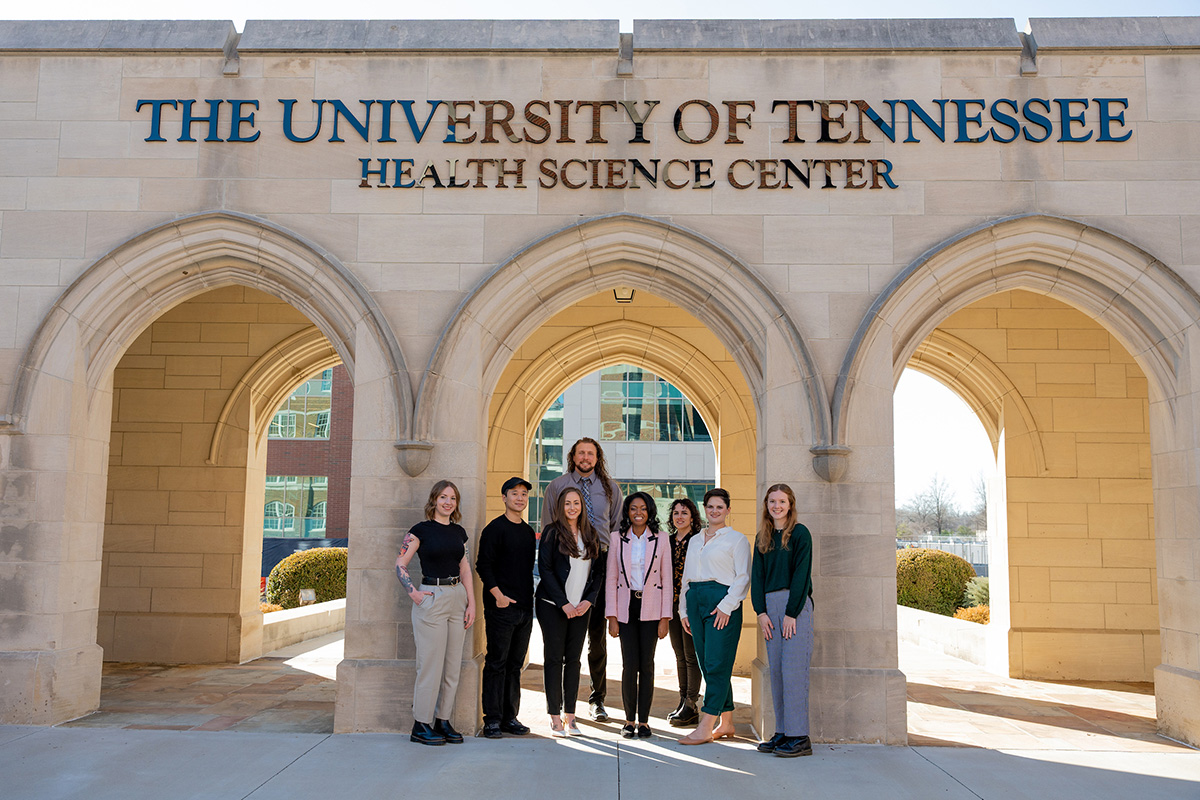
Shaping the Future of Pathologists’ Assistants
UT Health Science Center’s Pathologists’ Assistant program is more than just a degree—it’s
a pathway to a rewarding career in medicine. Under Weitzeil’s leadership, the program
continues to grow, providing students with a top-tier education that prepares them
for the demands of the field. As the feel of Pathologists’ Assistants gains recognition
and demand increases, UT Health Science Center is ensuring that its graduates are
among the best in the profession. With hands-on training, dedicated faculty, and a
commitment to excellence, the university is shaping the next generation of Pathologists’
Assistants that will play a vital role in our country’s health care system.
Anyone interested in becoming a Pathologists’ Assistant or learning more about UT Health Science Center’s program can visit the program webpage.
Anyone interested in whole body donation at UT Health Science Center is encouraged to visit the Anatomical Bequest Program webpage or call their office at 901.448.5978.
The Value of Hands-On Learning: Joshua Archer’s Journey in Medical School And the Impact of Gross Anatomy Labs
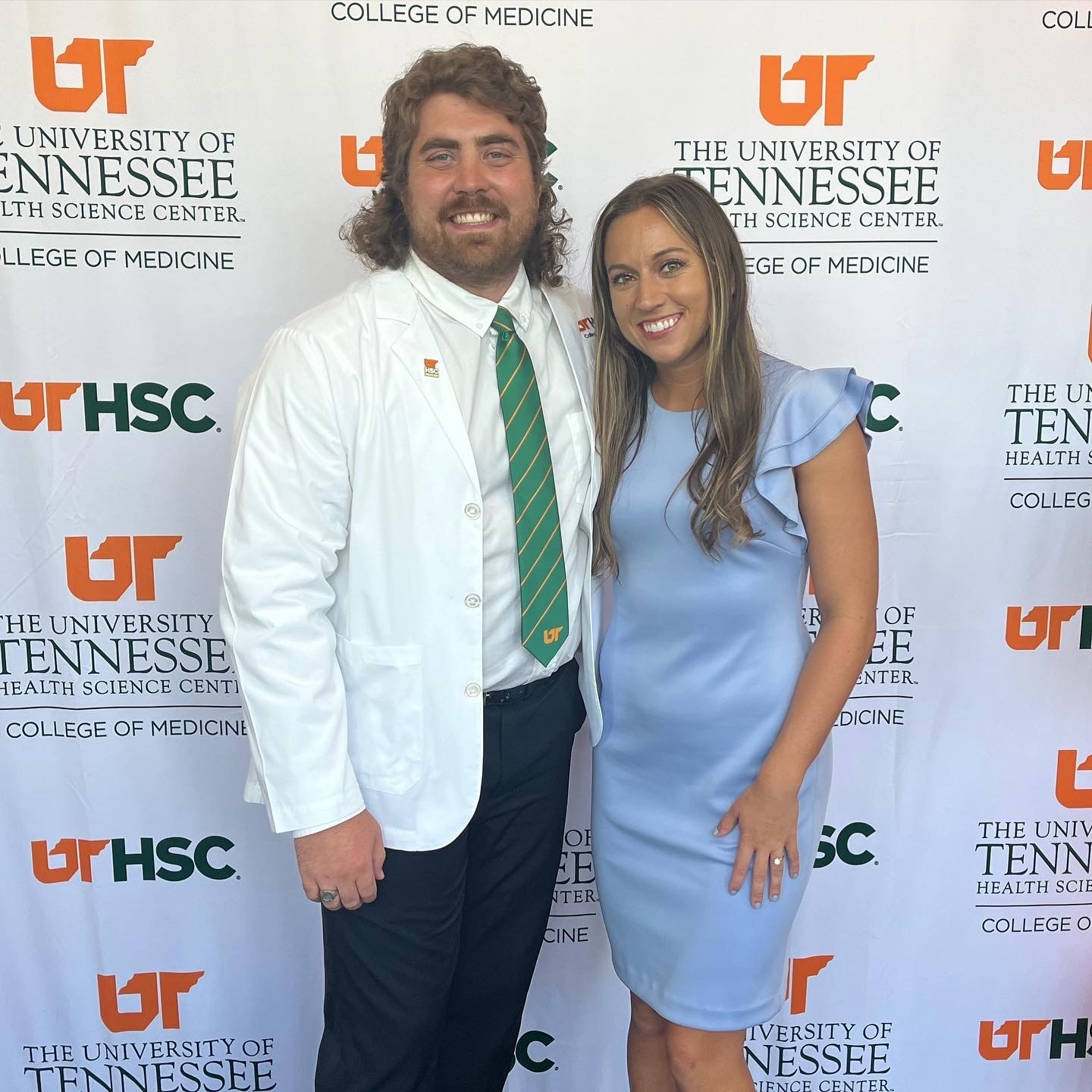
In recent years, the world of medical education has seen tremendous changes, particularly with the rise of virtual learning environments. While digital tools have their merits, they often lack the depth of real-world experience, especially in areas such as gross anatomy. Joshua Archer, a third-year medical student at the University of Tennessee Health Science Center (UTHSC), has experienced both virtual and in-person anatomy training. His story highlights the lasting impact of hands-on learning in a gross anatomy lab and how it shaped his medical journey.
A Small-Town Beginning to a Medical Dream
Joshua Archer grew up in a small farming town near Denver, Colorado, where his first
aspirations of becoming a doctor occurred at the age of eight. His inspiration came
after undergoing surgery, a moment that left a lasting impression on him. “I was really
nervous, but the surgeon was such a calming presence. He explained everything to me
in a way that I could understand,” Archer recalled. Inspired by the kindness and care
of his orthopedic surgeon, Archer told his mother that he wanted to become a doctor
on their way out of the clinic - and he never wavered from that plan.
Years later, Archer moved to Nashville, Tennessee, to pursue his undergraduate degree at Belmont University, where he excelled as a student-athlete in baseball and track. Majoring in biochemistry and molecular biology, Archer also explored his deep Christian faith, studying various world religions and nearly completing a minor in religious studies. It was during this time that he met his wife, who was also an athlete in track and field. The two have been married for just over a year, continuing their journey together as Joshua works toward his goal of becoming a physician.
Post-Medical School Aspirations
As a child and young athlete, Archer spent his fair share of time receiving orthopedic
care, which naturally led him to consider a career in orthopedics. "Playing sports
growing up, I needed a lot of orthopedic treatment," Archer said. "It was something
I was familiar with, and I always thought I would pursue that specialty." However,
his path began to evolve during medical school, particularly after an obstetrics and
gynecology rotation. “I got to assist in delivering babies, and I absolutely loved
it,” Archer shared. “I’m still leaning toward orthopedics, but I also know I would
be happy working in OB. Either way, I know I want surgery to be a big part of my career.”
Gross Anatomy Lab: A Foundational Experience
For Joshua Archer, one of the most pivotal experiences in his medical training came
during his first semester in the gross anatomy lab. “I think the lab portion of the
course was by far the most interesting, impactful, and the thing I go back to the
most throughout my education process,” Archer said. “For me, actually having the gross
anatomy lab was one of the main reasons I chose UTHSC over some of my other options.”
The hands-on nature of the gross anatomy lab is helping to solidify Archer’s understanding of the human body in ways that textbooks and virtual learning never could. “Learning from a textbook or lecture slides is good and important,” he explained, “but when you actually see the anatomy, hold it, and move it, it helps to solidify the information.” Archer’s passion for anatomy grew so much that he now tutors other students in the lab, helping them gain the same invaluable experience he has had. “I feel like lab is such a great way to study anatomy and learn it. Every time I’m in lab, my knowledge gets reinforced.”
Archer highlighted one particular day in the lab when information he learned in lecture and practical application in the gross anatomy lab intersected perfectly. “We were learning about some deformities and diseases of the kidney in lecture, and one of the main topics was a condition called horseshoe kidney. When we went into the lab to study on our donor, they actually had a horseshoe kidney. It was incredible to apply what we had just learned in such a practical way.”
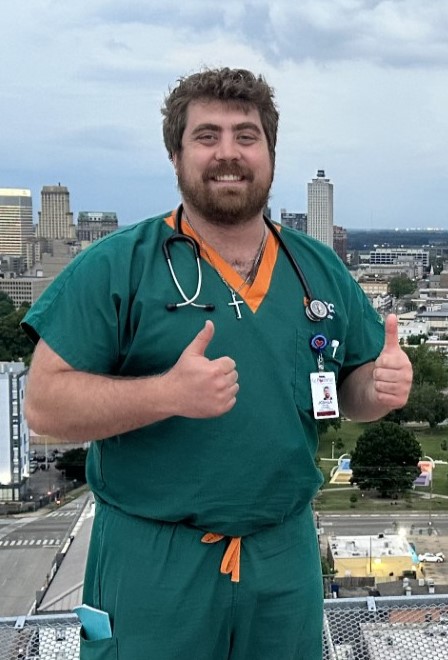
Virtual Learning vs. Hands-On Experience
The effects of the COVID-19 pandemic have pushed many medical schools throughout the
country to adopt virtual tools for teaching anatomy, and while Archer acknowledges
the benefits of virtual learning, he insists that it can never fully replace the in-person
experience of a gross anatomy lab. "There are some benefits to a virtual environment,"
Archer said. “It’s great for reviewing anatomy or supplementing what you learn, but
it makes such a big difference to actually see and work with real human anatomy. Handling
and practicing on the donors helps to solidify knowledge in a way that virtual learning
just can’t.”
Additionally, Archer views working with whole-body donors as an experience that goes beyond simply academic learning—it provides an emotional and ethical dimension to his medical education. “I view the donors you work on in the lab as the first patients that you have. You have to take care of them properly and realize that they were a donation given for your learning, and they really become your first patient,” he reflected. “That is an experience you miss out on if you are learning anatomy in a completely virtual setting.”
Gratitude for Donors and Their Families
Archer also expressed deep gratitude for the donors who made the choice to donate
their bodies to science, as well as thankfulness for the families of the donors who
often make sacrifices to support the decision. One thing donor families give up is
the ability to have a funeral or viewing with the body of their loved one present.
For some donor families, It’s a significant sacrifice to support whole-body donations.
Archer explained how he would want to express his thanks to those families directly:
“Your sacrifice has helped me learn in a way that is going to make me a better doctor.
I’m going to be able to take better care of you someday, or your kids, or your friends.
Thank you for giving me the opportunity to be better. It’s a huge sacrifice that will
positively impact hundreds of thousands of patients across the entire country.”
The Path Forward
As Joshua Archer moves forward in his medical education, his experiences in the gross
anatomy lab continue to influence his path. Whether he chooses orthopedics, obstetrics,
or ultimately falls in love with a completely different specialty, the hands-on learning
he gained in the gross anatomy lab has equipped him with the knowledge, skills, and
empathy that are crucial for any physician. Archer’s journey serves as a powerful
reminder of the irreplaceable value that whole-body donation adds to the education
of our health science professionals.
Conclusion
If you are interested in becoming a whole-body donor, please reach out to us at 901.448.5978,
or email aaron@uthsc.edu. From Joshua and the Anatomical Bequest Program at UTHSC, thank you to all of our
current and past donors and their families. Your impact and legacy will be forever
felt through the professional care that UTHSC-trained physicians provide to the world.
Knoxville’s Dani Bryant: A Path to Medical School Driven by a Passion for Anatomy and Patient Care
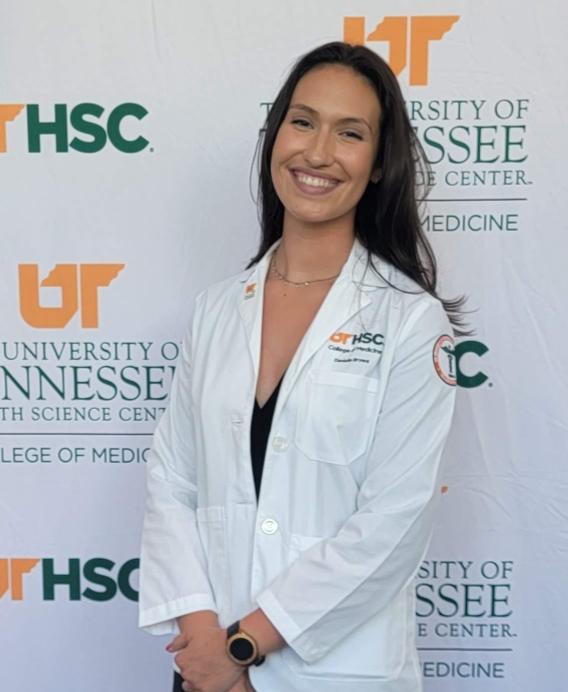
Dani Bryant, a third-year medical student at the University of Tennessee Health Science Center (UTHSC), has been focused on a career in medicine from the time she was a young girl. Originally from Knoxville, Tennessee, Dani grew up with a strong support system that encouraged her dream of becoming a doctor. Her mother, a CPA, and her father, a sales representative for a trucking line, instilled a work ethic that would shape her pursuit of medicine. “My parents got me little anatomical skeletons and anatomy textbooks when I was younger and encouraged me from a young age to learn all I could,” Dani recalls.
Throughout her educational journey, Dani developed a deep passion for anatomy, which would eventually define her approach to learning medicine. From assisting in anatomy labs as a TA during her undergraduate years to now tutoring other health science students in the anatomy lab at UTHSC, Dani’s experiences have shaped her perspective on the importance of anatomy and its impact on understanding the human body.
A Lifelong Dream Supported by Hands-On Experience
While her path toward medicine was inspired at a young age, Dani’s first-hand experiences
solidified her decision to pursue this challenging field. Growing up in Knoxville,
Dani would eventually attend Powell High School. During her time at Powell, she tore
her ACL and meniscus while playing sports. This was an injury that required the attention
of an orthopedic surgeon. The experience had a profound effect on her. “My surgeon
spent a lot of time talking with me about medicine and let me stay awake until right
before the surgery so I could see the operating room,” Dani shares. "He was an incredibly
kind man and encouraged me to continue pursuing medicine.” It was a pivotal moment,
motivating her not only to heal but also to help others who face similar physical
setbacks.
Following her graduation from Powell High School, Dani moved to the Johnson City area and attended Milligan University, a Christian liberal arts college, where she not only played college basketball but also worked extensively in the anatomy lab. Following her initial courses in Anatomy, Dani became a teacher’s assistant in the lab, helping her gain invaluable experience in prosecting cadavers and guiding her fellow undergraduates. “Anatomy lab gave me a lot of confidence in undergrad, and it made learning about the diseases that affect people much easier because you can physically see how diseases are changing the structures of the body,” she explains. This experience allowed her to understand the complexity of the human body, something that would prove critical in her transition to medical school.
The Power of Anatomy in Medicine
For Dani, gross anatomy lab has provided more than just technical knowledge; it has
been instrumental in her development as a future physician. The hands-on exposure
to cadavers brings her textbook knowledge to life, deepening her understanding in
ways that lectures and diagrams simply couldn’t match. Dani’s time in the anatomy
lab has not only helped her in her classes and exams, but also in the practical application
of medicine when she is participating in clinical rotations. “I am a big visual person,
so now that I am in clinic, I can visualize where muscles are in the body, and how
a particular muscle or bone would react to an injury.”
Dani emphasizes the importance of seeing the physical effects of diseases in real life. “It’s one thing to say ‘smoking is bad for you,’ and it’s another to physically see someone’s lungs that are black and shriveled,” she says. Such encounters with real-life anatomy gave her an appreciation for how disease impacts the body, an experience that not only strengthened her knowledge but also gave her the confidence she needed to progress in her career.
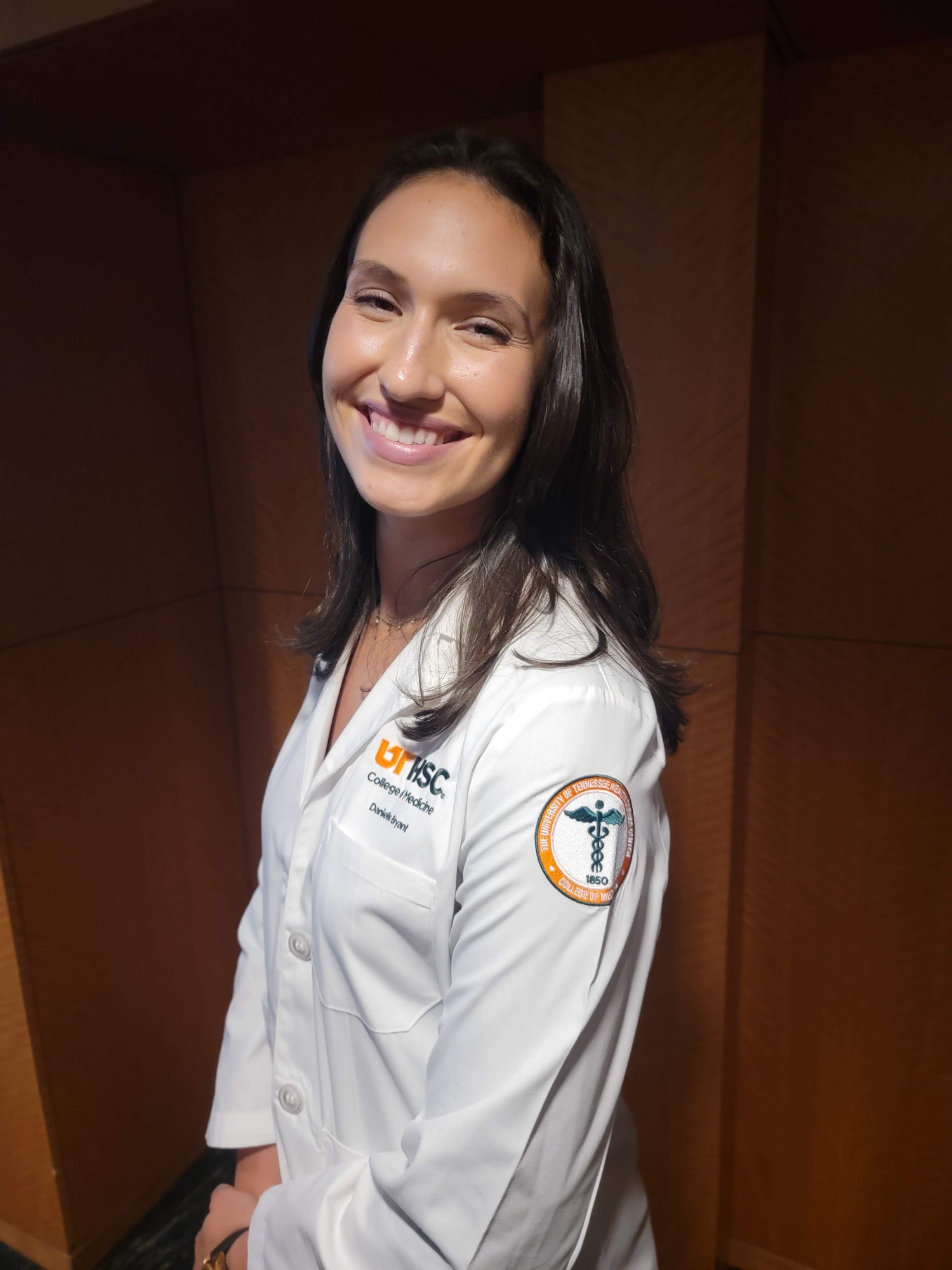
Carrying Knowledge from Anatomy Lab to Clinical Rotations
Now, as a third-year medical student, Dani is in the midst of her clinical rotations,
a phase that has allowed her to apply the foundation she built in the anatomy lab
to real patient care. This unique hands-on training enables her to understand the
normal and abnormal anatomy she encounters in clinical settings. “Anatomy lab provided
a really good base from an orthopedic standpoint to understand where all of those
muscles, arteries, and nerves are that they tell you about in a textbook,” she explains.
The practical experience with cadavers has assisted her as she learns to interpret
and diagnose anatomical changes caused by injury.
When comparing her experience to those who only had textbook-based anatomy courses, she feels fortunate to have had access to gross anatomy labs which have helped deepen her understanding. “When I compare my experience with people that had anatomy that was mostly taught out of a textbook or PowerPoint, they didn’t really have that deep understanding about where structures are and how they work, or what the real life implications of some of those diseases were”, she reflects.
Honoring Donors Through Respect and Compassion
Dani’s appreciation to human anatomy is reflected in her profound respect for the
donors who make this learning possible. Working with cadavers is an experience that
Dani never takes lightly. “I always try and remember that this is a person I am working
on that used to have hopes, dreams, jobs, and a family,” she shares. This perspective
helps her connect more deeply with her studies, viewing each donor as her “first patient.”
She feels that the opportunity to learn from donors provides her with an invaluable
gift—a sentiment she would share with any donor family if given the chance.
“If I had the ability to speak with the family and friends of my donor, I would want to thank them and tell them how beneficial their family member was to not only my education, but also to my future patient’s outcomes,” Dani says. She emphasizes that not only are these donations appreciated, but they are also treated with the utmost respect by her and her peers. “We try to do our best by our donors…to use their donation in a way that honors their memory,” she adds.
A Future in Orthopedic Surgery and Teaching
Looking ahead, Dani envisions a career in orthopedic surgery, inspired by her own
injury and recovery journey. She is particularly interested in helping young athletes
and children, giving them a chance to enjoy a normal childhood despite the challenges
of injuries. As she progresses through her rigorous training, which will include a
competitive five-year residency, Dani remains motivated by her long-standing passion
for medicine and anatomy.
In the future, she hopes to stay in Tennessee, ideally coupling her role as a surgeon with working in an academic teaching center where she can continue the tradition of mentorship that has been so instrumental in her own journey. She envisions a future where she can contribute not only as a skilled surgeon but also as a mentor in an anatomy lab, guiding the next generation of health care professionals. “I’ll probably still be teaching anatomy labs well into my retirement,” she jokes, but there’s truth in her words. Dani is committed to passing on her knowledge, knowing firsthand the impact that dedicated mentors and selfless whole-body donors have on aspiring medical students.
"Honoring the Gift: Dr. Austin Dalgo Highlights the Sacred Role of Whole-Body Donations"
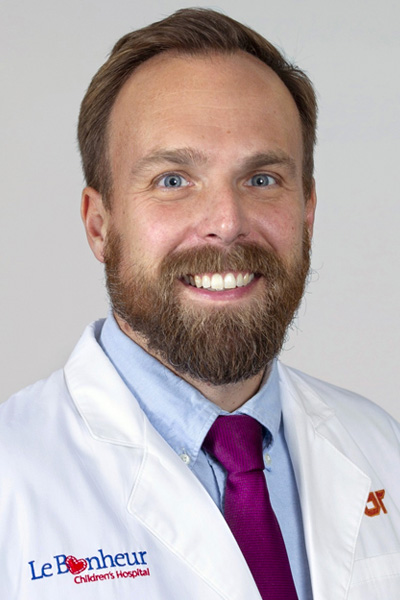
Dr. Austin Dalgo, MD, a compassionate Palliative Care Physician at LeBonheur Children’s Hospital and Associate Professor at UTHSC, recently spoke to a group of UTHSC medical students. In his speech, he focused on inspiring the students to reflect on the sanctity of whole-body donations and he encouraged them to let the gravity of these anatomical gifts shape their experiences and careers. “We are all called to practice with the highest ethical standards, upholding the dignity and sacredness of each person. May we all uphold the humanity and beauty of these people’s lives by knowing their body, imagining their stories, and understanding the process by which they came into our hands”, he said.
The use of human cadavers has been involved in the pursuit of furthering medical knowledge for more than a century. Regrettably, high standards and ethical integrity haven’t always accompanied the process of human dissection in our country and throughout the world. There have been multiple instances, including in the recent past, where the living seemingly took advantage of the dead, presumably excusing their actions through the noble cause of advancing medicine and healing. There must be a way to accomplish this need for furthering knowledge, while also honoring and respecting the very decedents who make this crucial educational experience possible.
At The University of Tennessee Health Science Center, we aim to be a leader in the endeavor of improving the health sciences, while also paying homage to the people who give their bodies to enable the rest of us to learn. Impactful instructors continuously impress upon the minds of our students the importance of caring for and honoring the cadavers in our care. In his speech, Dr. Dalgo continued, “Remember too, that many of the people voluntarily and sacrificially offered their treasure, their body, to you for your education. They undoubtedly wanted to share sacred lessons with you by literally sharing their self with you. Learn the mechanics and the anatomy, of course, but learn that people deeply care about your knowledge.”
All of us at UTHSC owe a debt of gratitude to every individual who chooses to donate their body to our cause. We invite everyone to consider the vastness of medical knowledge that our society holds, and realize that our ability to be healed from sickness and injury has been profoundly impacted by the anatomical study of deceased individuals. Let us be grateful for them, and strive as a society to ensure that there is no room for mistreatment of the dead, especially within the realms of medical research.
Murfreesboro's Own Klara Houck: Her Journey Through Medical Education
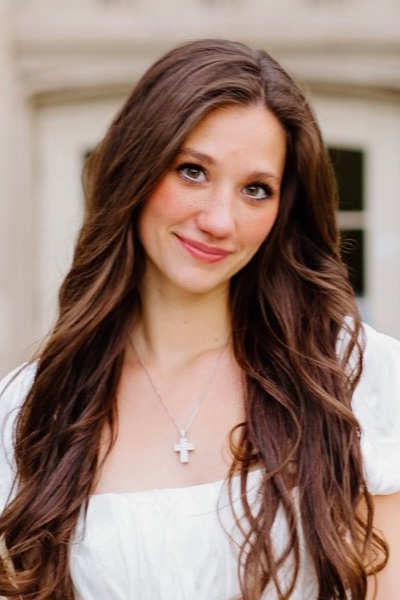
Klara Houck's journey into the world of medicine began long before she set foot in a medical school classroom. With a father who is a general thoracic surgeon, Klara often found herself captivated by the stories of patient care. “From the moment I could talk, my mom said I would follow my sister around the house, making her play doctor with me,” Klara recalls. Her curiosity only deepened as she watched her father interact with patients, often asking if she could accompany him to work instead of going to school. Her family moved around a few times while she was growing up, but they landed in Murfreesboro, Tennessee, which is where Klara attended high school. Klara’s high school offered a technical pathways program that was focused on introducing students to the subject of medicine. Her time spent in that program further solidified her aspirations of becoming a doctor.
Klara’s academic journey took her to the University of Tennessee, Knoxville, where she majored in neuroscience and biochemistry, while also minoring in psychology and public health. The combination of these fields provided her with a comprehensive understanding of both the scientific and social aspects of healthcare. “Public health and psychology were a lot more thought-provoking,” she notes, reflecting on her undergrad experience. Alongside her studies, Klara actively participated in research projects that enriched her academic foundation, allowing her to apply theoretical knowledge in practical settings.
Empowering the Next Generation
Beyond her academic achievements, Klara's commitment to community service has been
a significant aspect of her journey. As a member of her sorority, she organized volunteer
projects aimed at empowering young girls in her community. “We wanted to instill the
confidence of sisterhood and women’s outreach within them,” she explains. Activities
like dance classes and mirror affirmations provided a space for these young girls
to learn about self-advocacy and confidence in a supportive environment.
Additionally, Klara dedicated her time to Prevent Child Abuse America in Knoxville, where she supported children facing difficult home lives. “Helping those who are vulnerable and in need has always been important to me,” Klara states, emphasizing her passion for advocacy and support. Her love for animals also led her to volunteer at local animal shelters, walking dogs and providing care for animals in need.
A Passion for Anatomy
As she embarked on her medical school journey, Klara knew that the anatomy lab would
play a crucial role in her education. “The most important part of the anatomy lab
is that when you walk in there after being in lecture for hours, you can reflect on
what you’re learning and remind yourself that you are dealing with people,” she explains.
This perspective is vital, as it reinforces the human element of medicine, reminding
students of the responsibility they will carry in their future careers.
Klara recalls her initial feelings of nervousness when entering the anatomy lab for the first time. “I didn’t know what to expect, and I had never done anything like it before,” she admits. However, she and her anatomy group adopted a practice of “thinking and thanking” at the start of each lab session, honoring their donor who was making their anatomy lab education possible. This approach helped them connect with their donor and appreciate the profound impact that this individual had on their learning experience.
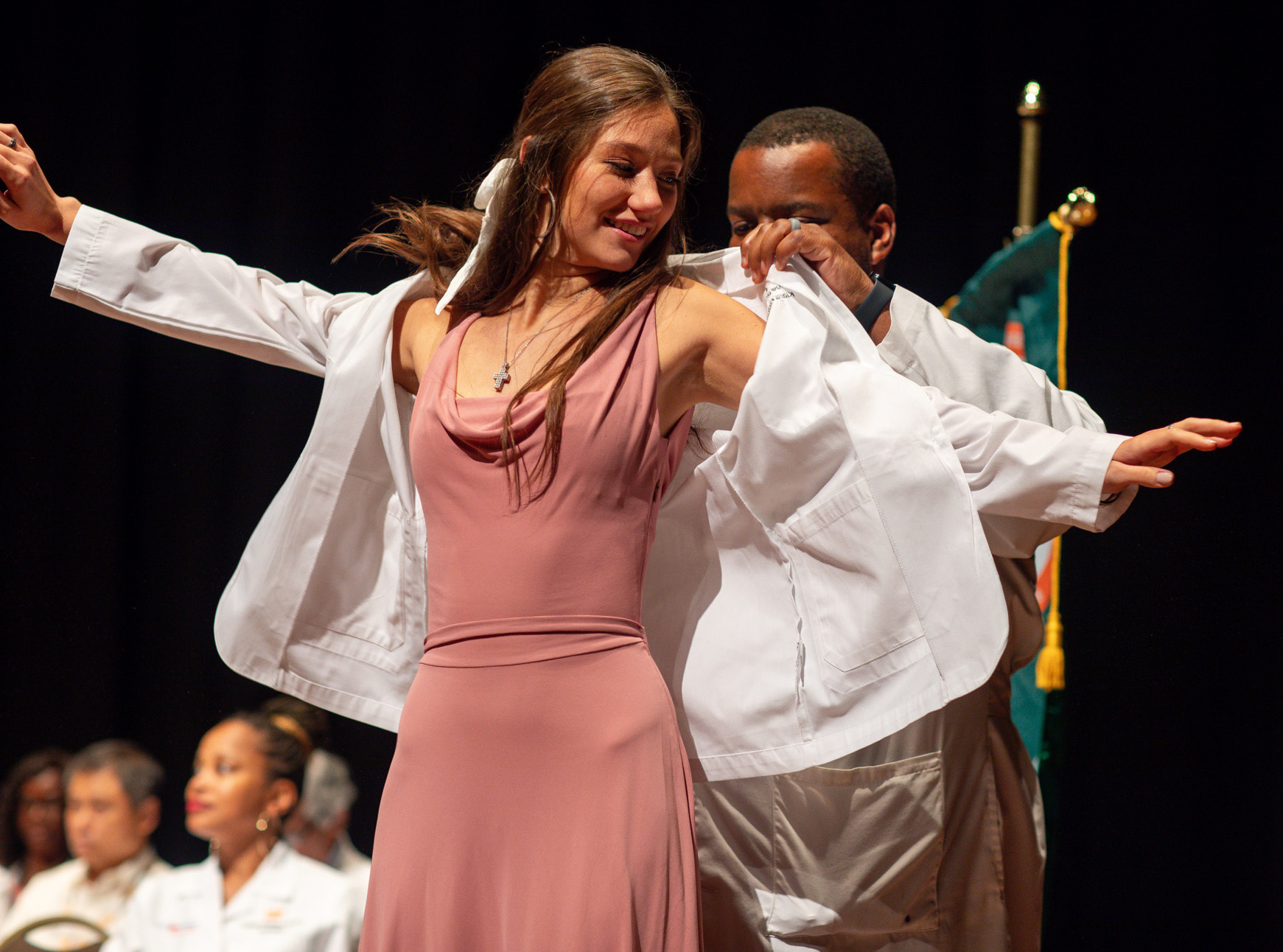
A Deep Connection to Her Anatomy Lab Donor
The anatomy lab has been more than just a place for practical learning for Klara;
it has also been a space for reflection and growth. “Anatomy really helped me center
myself and reflect,” she says, acknowledging the importance of mastering the material
to better understand future patients. The unique opportunity to learn from human donors
is a critical component of medical education, especially for first-year students who
have yet to experience clinical rotations. “We are going to have people relying on
us and trusting us to make decisions and it's important that we remember the information
and master the information so that we can understand the patient better. I think that
is one thing that anatomy lab is able to give you as a student,” Klara said.
Looking to the Future
Klara’s aspirations in medicine are as impressive as her accomplishments thus far.
With a clear passion for the thoracic cavity, she is particularly drawn to cardiology.
“I love the heart and lungs and everything that goes along with the anatomy and physiology
of the thoracic cavity,” she states. Although she is still keeping an open mind about
her specialty, Klara is weighing the possibility of becoming a cardiothoracic surgeon
versus a medical cardiologist. “I absolutely love cardiology. I could stare at EKGs
all day and just be very content,” she says, reflecting her enthusiasm for the field.
Her clinical experiences have opened her eyes to the importance of building relationships
with patients. While she appreciates the technical aspects of surgery, Klara has started
to fall in love with the connection formed during patient interactions.
A Bright Future Ahead
Klara Houck embodies the qualities of a compassionate and dedicated future physician.
Her academic achievements, commitment to community service, and profound experiences
in the anatomy lab all contribute to her growth and readiness to take on the challenges
of the medical field. With a heart for helping others and a mind eager to learn, Klara
is well on her way to making a significant impact in the world of medicine. As she
navigates her journey, she carries with her the lessons learned from her donor, her
community work, and her family’s legacy—each shaping her into the compassionate physician
she aspires to be.
Second Year Medical Student Ronald Throop Shares How the Anatomical Bequest Program at UTHSC has Impacted His Education
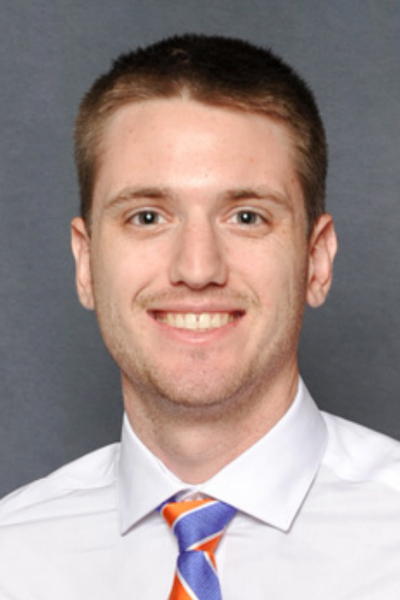
Ronald Throop, a second-year medical student at The University of Tennessee Health Science Center (UTHSC), has always had a deep-seated passion for the medical field. For Throop, it started when he was young. His home middle school in West Palm Beach, Florida had a premed magnet program that he became involved in. Today, as he navigates the challenges of medical school, Throop reflects on how pivotal moments—like his first anatomy lab experience—have shaped his journey. His experience has been profoundly impacted by the Anatomical Bequest Program at UTHSC, a cornerstone of medical education within the institution. The body donation program has not only enhanced Throop’s learning but also deepened his sense of gratitude not only for the individuals who choose to donate their bodies, but also the families and friends who support those donations.
Throop’s interest in medicine began early. Growing up in West Palm Beach, Florida, he attended a middle school with a premed magnet program that allowed him to learn about the medical field. "We did multiple animal dissections," Throop recalls. These dissections, along with the other material taught in the magnet program, were a foundational experience that piqued his curiosity and set him on the path toward a career in medicine. Following high school graduation, Throop continued pursuing his medical school aspirations by enrolling at the University of Florida and majoring in microbiology and cell science. After four years of undergraduate work, countless hours of volunteering at local elementary schools and animal shelters, and numerous applications to medical schools throughout the country, Throop was accepted into the College of Medicine at The University of Tennessee’s Health Science Center in Memphis.
One of the most profound aspects of Throop’s medical education has been the body donation program. This program, which provides medical students with the opportunity to study and learn from a real human body, has been instrumental in shaping his understanding of anatomy and medicine. "Until you actually get in the lab and learn human anatomy firsthand, you miss out on grasping all of the concepts that are needed to become an effective healthcare provider," Throop emphasizes.
For medical students, a large portion of their time in the first semester is spent in the human anatomy lab. Throop recalls first stepping into the anatomy lab as a different and unusual experience. This was his first experience being in a classroom setting where human donors are the subjects of study, but he remembers it being a moment of deep reflection and gratitude. "The first time you enter the anatomy lab, it’s a mix of emotions. You’re excited to learn, but there’s also a sense of humility and respect for the donors who’ve made this possible," Throop shares. He quickly realized that studying human anatomy in such a direct way is essential for truly understanding the complexities of the human body—an understanding that textbooks, scientific models, or virtual materials could never provide alone.
After completing his first semester, Throop applied to become a tutor in the anatomy lab, a role that allows him to teach both dental and medical students who are in their first semesters of school. "Being able to actually teach something, and reinforcing the material, helps the person you are teaching, but it also helps you (as the teacher) to solidify the things you know and don't know," Throop explains. This opportunity not only reinforced his own knowledge, but it also highlighted the importance of the anatomy lab in developing competent healthcare professionals.
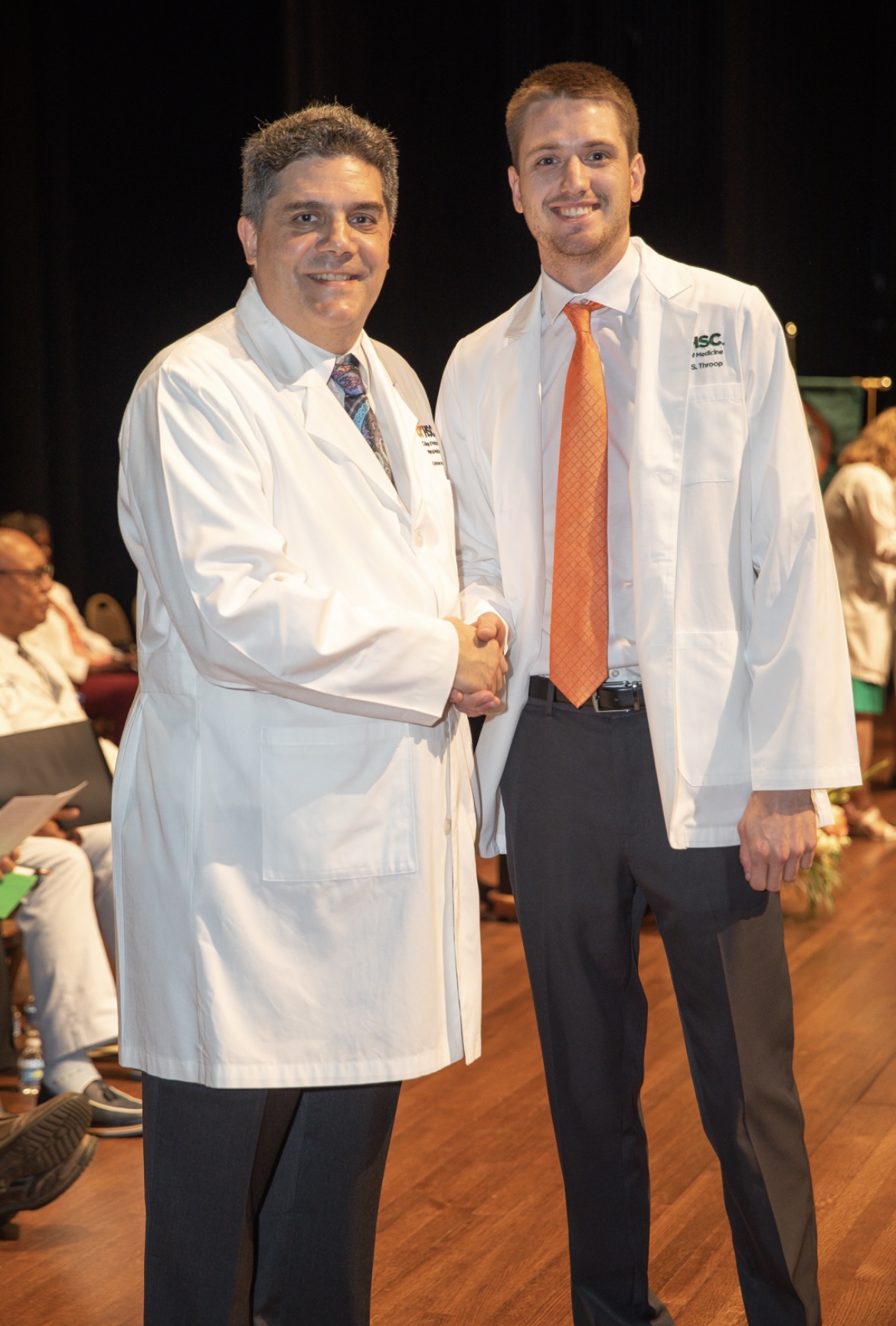
For Throop, the significance of the body donation program extends beyond just learning anatomy. It’s a deeply personal experience that fosters a sense of gratitude toward the donors and their families. If he were given the chance to speak with the family of his donor from the anatomy lab, Throop said, “I would want to tell them thank you and hope that they understand the impact their sacrifice made on me personally, as well as on all other students studying health science.” This sense of gratitude is a common thread among medical, dental, and other health science students who understand that their education is built on the generosity of others.
The Anatomical Bequest Program at UTHSC, and similar programs at medical schools across the country, rely on the generosity of individuals who choose to donate their bodies to science. These donations are critical for the education of future healthcare providers, as they provide unparalleled learning experiences that cannot be replicated through simulations or textbooks.
Throop’s experience highlights the importance of these programs. The impact of these donations is felt not only by the students who learn from them but also by the patients who will one day benefit from the skills these students acquire. If you are considering ways to contribute to the future of healthcare, registering for a body donation program is a powerful way to make a lasting impact. Your donation can help train the next generation of doctors, surgeons, dentists and other healthcare providers, equipping them with the skills and knowledge they need to save lives and make a positive impact on our world.
As Throop looks to the future, he envisions a career that allows him to combine his love for medicine with his passion for the outdoors. He hopes to work in a community that offers both professional fulfillment and opportunities for outdoor recreation. He is currently leaning towards specializing in anesthesia, though he also has enjoyed his coursework in orthopedics. Regardless of the path he chooses, the skills and insights gained from the anatomy lab and his teaching role will be invaluable. Following medical school, he plans to apply for a residency—a process that will add another four to five years to his education. Residency is where the broad knowledge gained in medical school is honed into the specialized skills needed for a chosen field.
No matter where his career takes him, the lessons learned in the anatomy lab—lessons made possible by the generosity of body donors—will remain a guiding force in his career as a healthcare provider. Throop’s journey through medical school is a testament to the power of education and gained experience. His story highlights the critical role that body donation programs play in shaping the future of healthcare. As Throop continues his studies and moves towards his residency, the lessons learned in the anatomy lab will be the foundation upon which his career is built—a career dedicated to serving others.
The Gift Of Knowledge: Kevin Zhang’s Journey Through Medical Education and Cancer Research
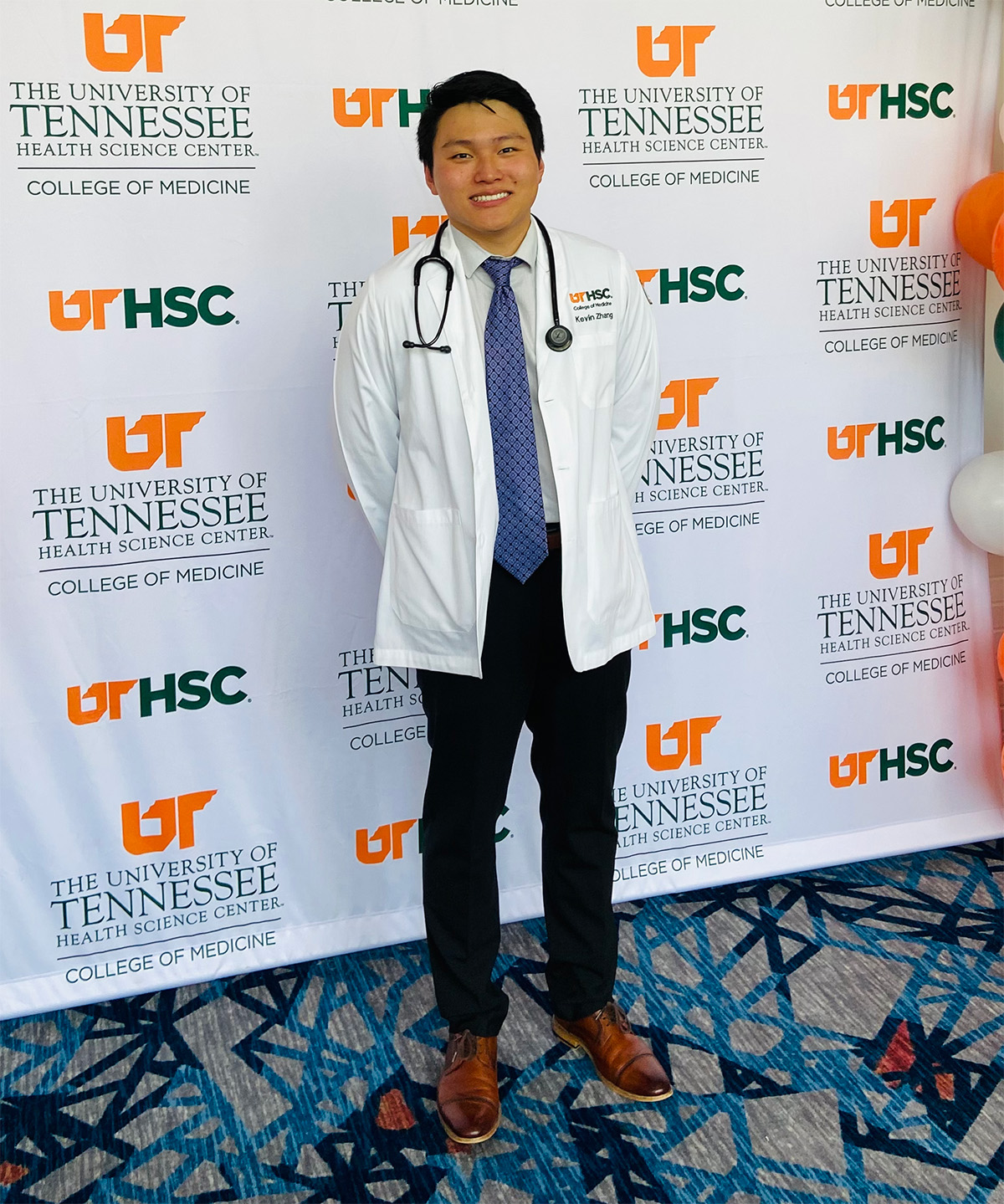
Kevin Zhang, a second-year medical student from Chapel Hill, North Carolina, has been considering the possibility of becoming a physician since high school. From his undergraduate research in cell biology, to his time spent in hematology labs at Northwestern University and St. Jude, to the impact of the gross anatomy lab at The University of Tennessee Health Science Center (UTHSC), Kevin’s path to becoming a doctor has been both thoughtful and inspiring. Here’s a look at how his research, medical aspirations, and appreciation for body donation have shaped his journey.
A Foundation in Research: From Northwestern to St. Jude
Growing up in Chapel Hill, NC, Kevin’s interest in biology sparked early, but it wasn’t
until his undergraduate years at Northwestern University that he found his passion
for medical research. Majoring in cell biology, Kevin thrived in the lab environment,
fascinated by the microscopic complexities that drive life. His curiosity led him
to opportunities beyond the classroom, and during his time in Chicago, Kevin contributed
to research on cancer cell behavior in a hematology lab, studying under a physician
who is blazing trails in the world of cancer treatment and understanding. Kevin’s
time spent in this lab sharpened his focus on oncology.
After earning his undergraduate degree, Kevin took a significant step by following this same physician to Memphis and joining St. Jude Children’s Research Hospital. During his first two years at St. Jude, Kevin played a critical role in research that explored the genetic factors contributing to Acute Myeloid Leukemia in Down Syndrome patients. The work he participated in with his research team culminated in a published paper, marking a major milestone for him and reassuring his desire to pursue a medical career. “Being able to feel like you are moving the needle, directing care somewhere, or that you are proposing a viable treatment plan and providing insight to a disease, it’s really useful for the whole field of medicine.” This research not only gave Kevin invaluable technical experience but also deepened his resolve to become a doctor.
Experience That Led to Choosing Oncology
Now a second-year medical student at UTHSC, Kevin is zeroing in on a future in oncology.
The field of oncology specializes in the diagnosis and treatment of cancer. His time
in the hematology labs at Northwestern and St. Jude fueled his interest in the field,
but it’s the human side of cancer care that resonates most with him. "In oncology,
you’re not just treating a disease. You’re treating a person, and you’re there for
every step of their journey," he explains.
While Kevin is still deciding between surgical oncology and medical oncology, he is leaning toward the latter. "Medical oncology allows you to build long-term relationships with your patients. You're there with them from diagnosis to treatment to hopefully recovery, and that’s something I really value," Kevin says.
Human Anatomy at UTHSC
While Kevin’s path to medicine was paved with hands-on experience and research, his
time in the gross anatomy lab at UTHSC has become one of the most meaningful aspects
of his medical education. Like many health science students, Kevin was both excited
and apprehensive when he first entered the lab. He remembers the experience being
a little bit of a shock at first. This was his first anatomy course where real human
donors were the subject of study. However, he now recounts the experience as being
crucial to his educational development. “Just seeing the actual muscles, organs, and
anatomy and physiology within a human body was remarkable. You never appreciate it
fully with the diagrams or models that they show you,” Kevin said. This hands-on experience
has also influenced Kevin’s role as a tutor for first-year students. After being deeply
impacted by his time in the lab, Kevin felt compelled to help others gain the same
understanding.
Honoring the Gift of Body Donation
Kevin holds a deep sense of gratitude for the donors and their families who make the
gross anatomy lab possible. When reflecting on the impact anatomy lab has had on him,
Kevin said, “My donor helped me learn and make sure that I go into the world ready
to handle situations as a doctor. My understanding would never have been as deep as
it is now without my donor.”
He recognizes the sacrifices made by donor families and believes their contribution is a crucial part of medical training. For all of the health science students, there is a level of respect and responsibility that comes with working with these donors. They are not just teaching tools—they are people who have given students at UTHSC an opportunity to learn.
Looking Ahead: A Future in Oncology
As Kevin moves forward in his medical school journey, his vision for the future is
clear. With a strong foundation in research and a deep appreciation for patient care,
he hopes to combine these passions as an oncologist. Whether in a research lab or
by his patients’ side, Kevin’s commitment to advancing cancer treatment and care is
clear, and his journey is only just beginning.
